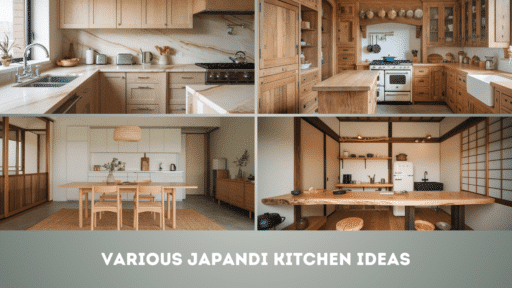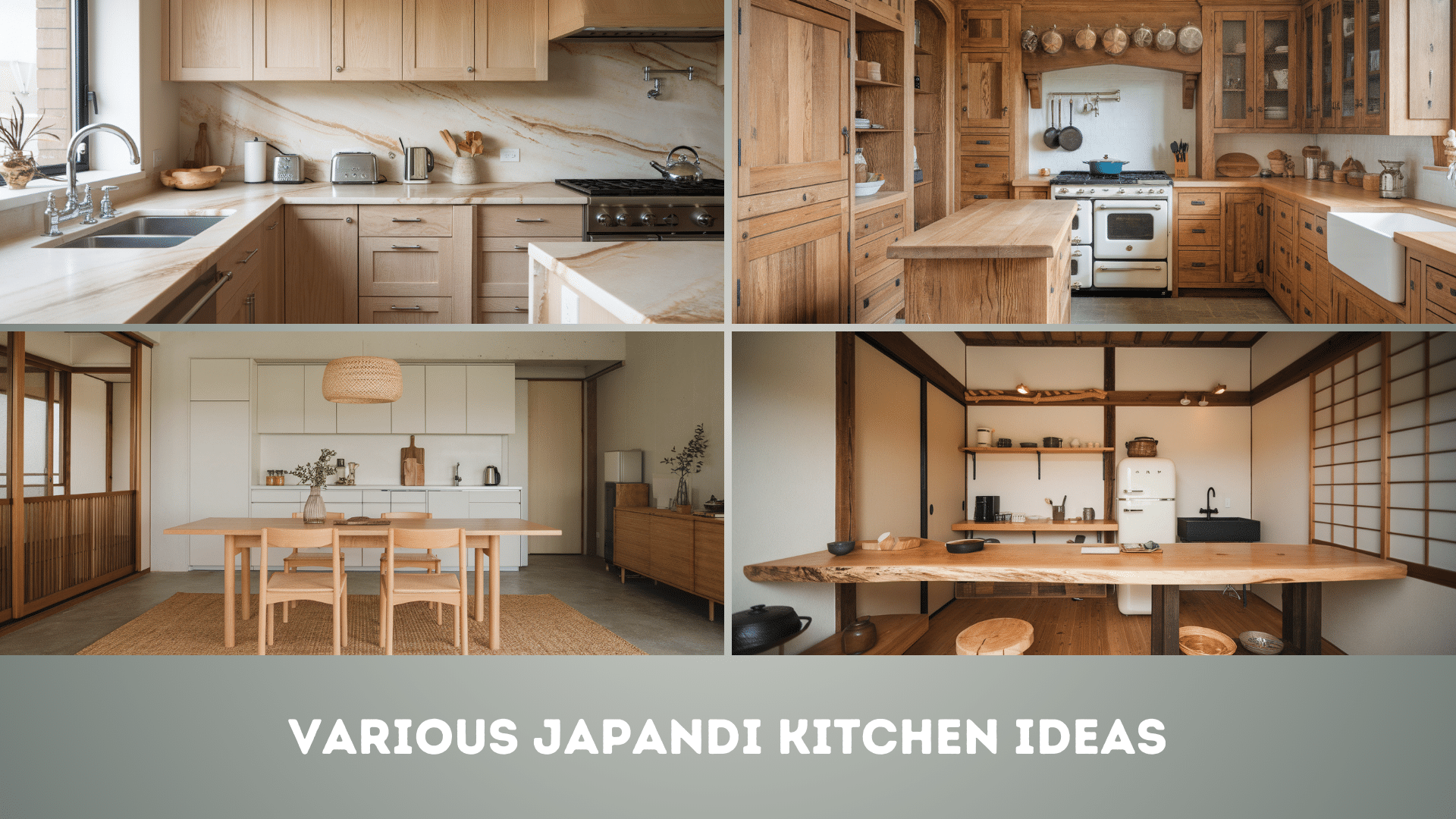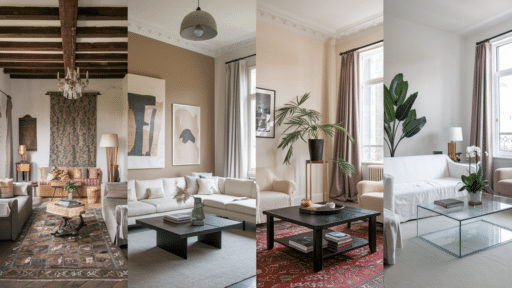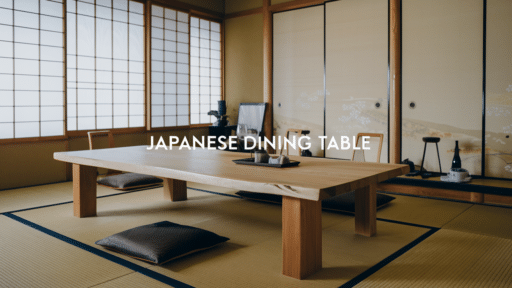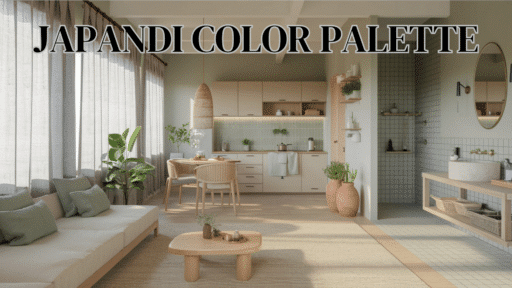The fusion of Japanese and Scandinavian design – known as Japandi – has taken the interior design world by storm, and nowhere does it shine quite like in the kitchen.
It’s all about finding that sweet spot between cozy and minimal, where every element serves a purpose while looking effortlessly stylish.
Think warm woods meeting sleek surfaces and natural materials paired with modern touches. Whether you’re styling cabinetry or choosing a low-profile luxury couch for an open-plan space, Japandi makes every piece feel intentional. You’re in the right place if you dream of a zen and welcoming kitchen.
We’re going into practical ways to bring this timeless style into your kitchen, from smart storage solutions to that perfect mix of textures and colors.
When planning a complete renovation or adding a few Japandi touches, these ideas will help you create a beautiful and functional space.
Modern Appeal of Japandi Kitchens
1. Add Natural Wood Shelving
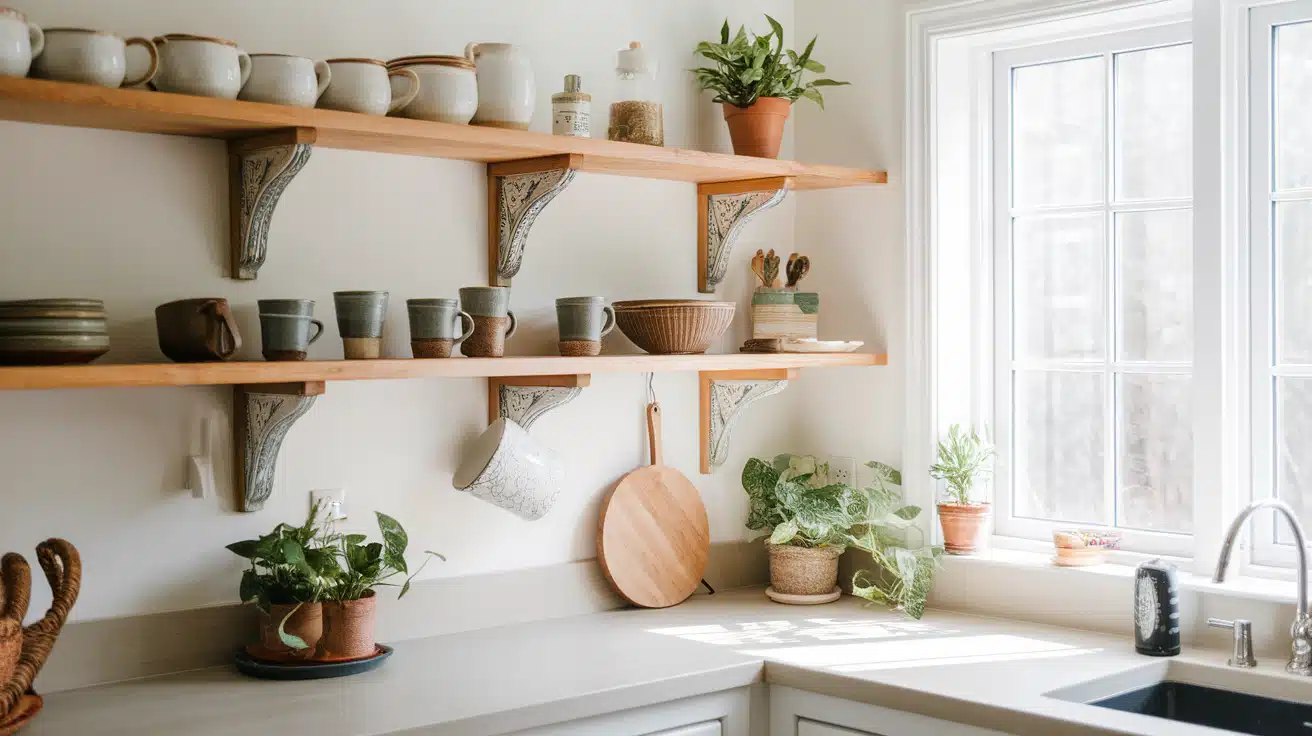
Natural wood shelving adds warmth and a touch of nature to the kitchen. Open shelves provide easy access to everyday items while promoting a clutter-free environment.
Key points of this idea:
- Enhances warmth and natural charm.
- Provides functional and accessible storage.
2. Combine Matte Black Appliances with Light Oak Cabinetry
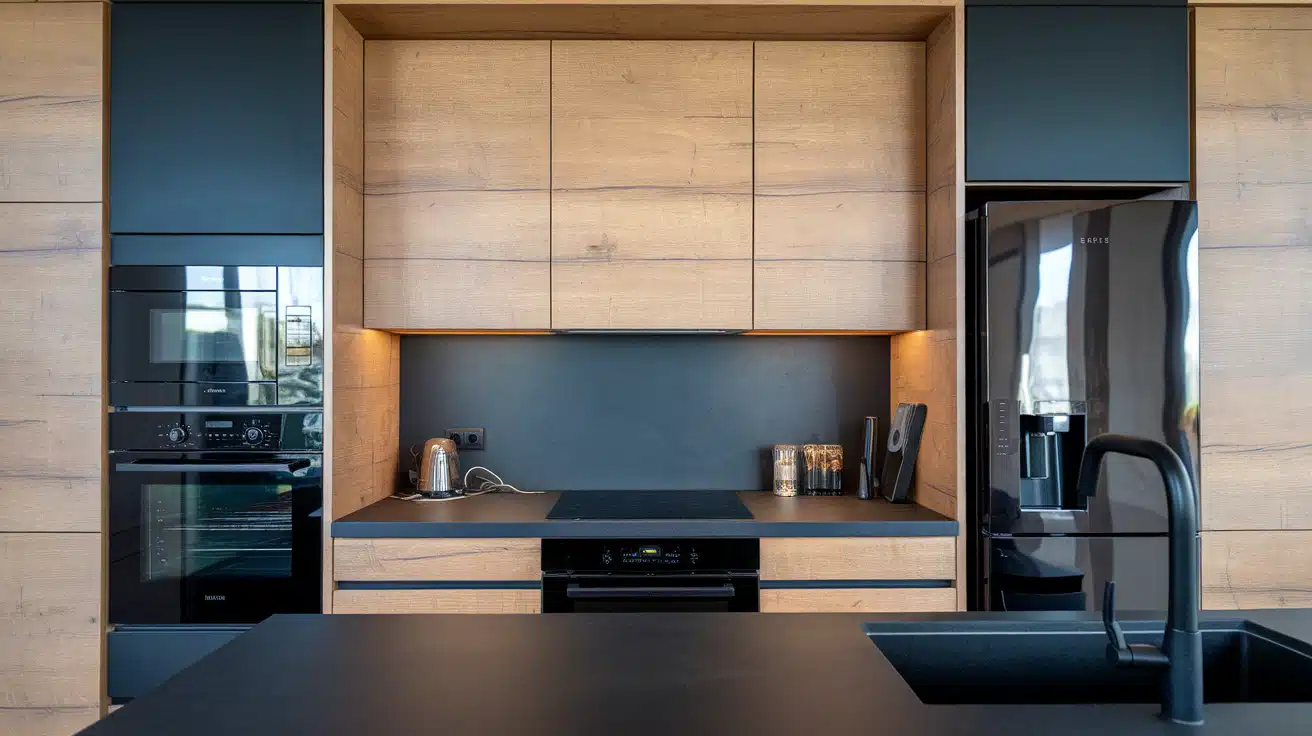
Pairing sleek matte black appliances with light oak cabinetry creates a balanced look. The contrast between dark and light elements brings depth and warmth to the kitchen.
Key points of this idea:
- Creates a striking contrast between dark and light elements.
- Brings warmth and modern style to the kitchen.
3. Create a Minimalist Layout
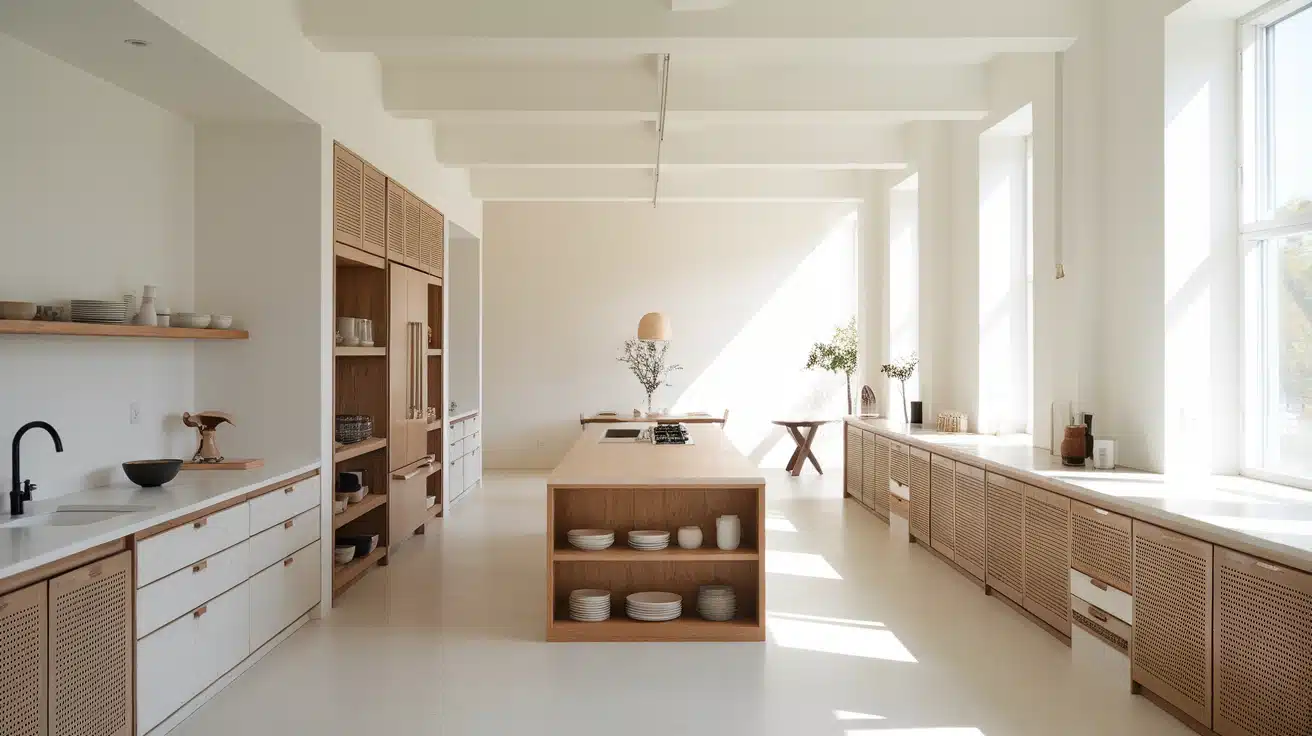
A minimalist layout with clean lines and simple storage keeps the kitchen uncluttered, allowing natural materials and functional design to take center stage.
Key points of this idea:
- Focuses on simplicity and clutter-free surfaces.
- Maximizes space efficiency and visual openness.
4. Accept Neutral Color Tones
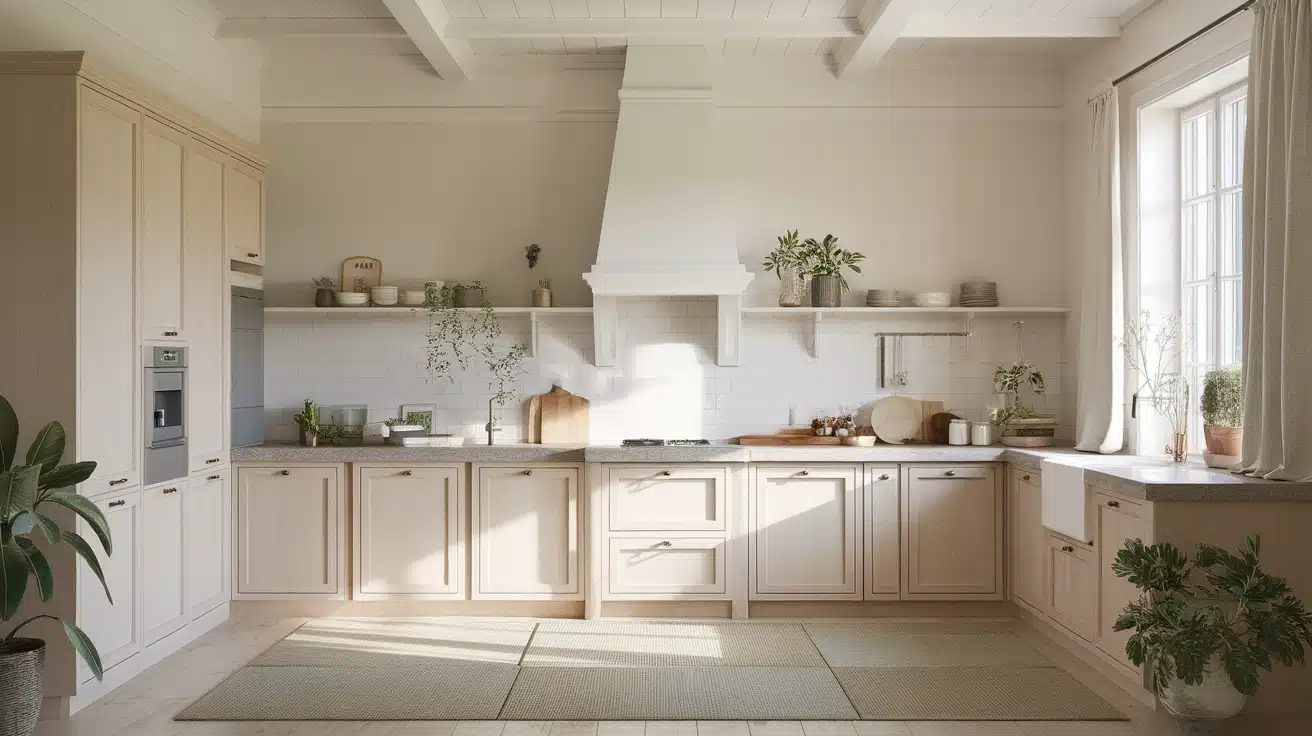
Neutral tones like beige, gray, and white foster a calm and open environment. These tones complement natural materials and create a harmonious and timeless kitchen space.
Key points of this idea:
- Enhances spatial harmony and tranquility.
- Focuses on a clean, neutral base for easy pairings.
5. Black and White Ceramic Tiles for The Backsplash
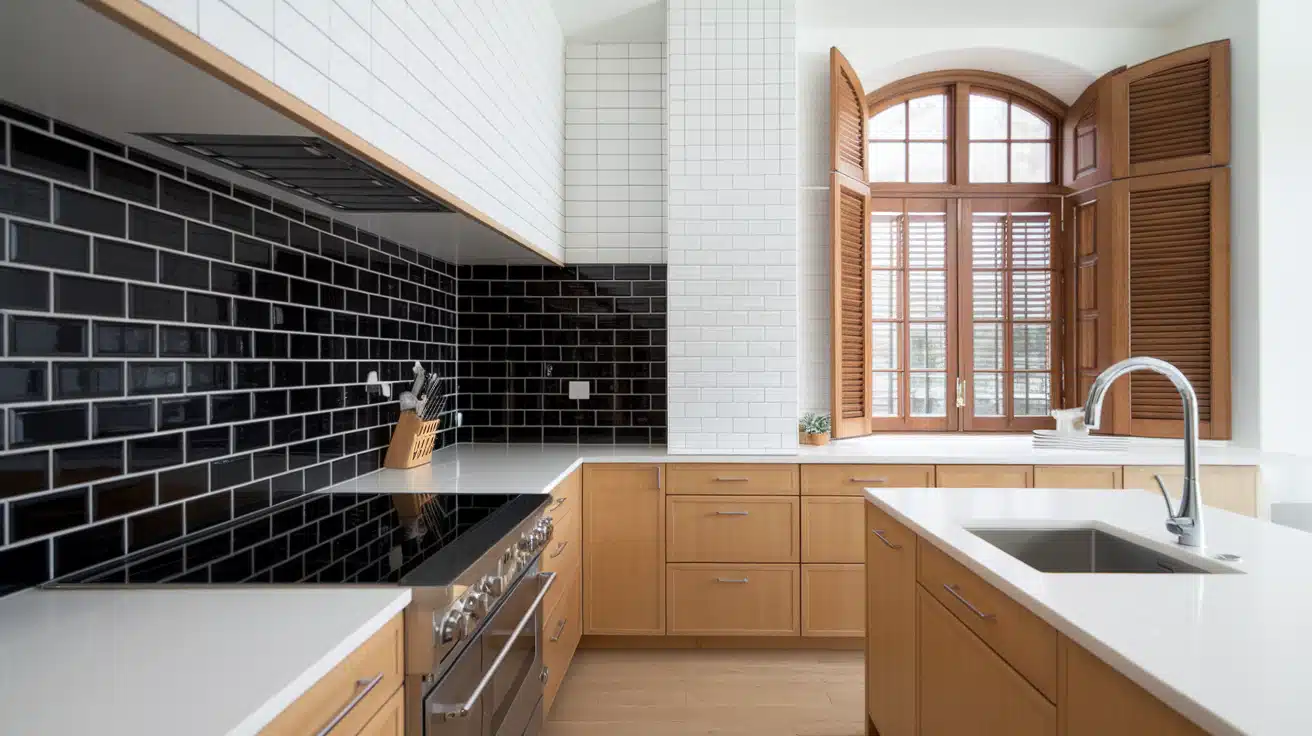
Black and white ceramic tiles bring a modern, sleek feel to the kitchen. These timeless tiles work well for the backsplash, offering durability and easy maintenance.
Key points of this idea:
- Adds timeless contrast with a modern twist.
- Durable and easy to clean for long-term functionality.
6. Install a Simple, Sleek Kitchen Island
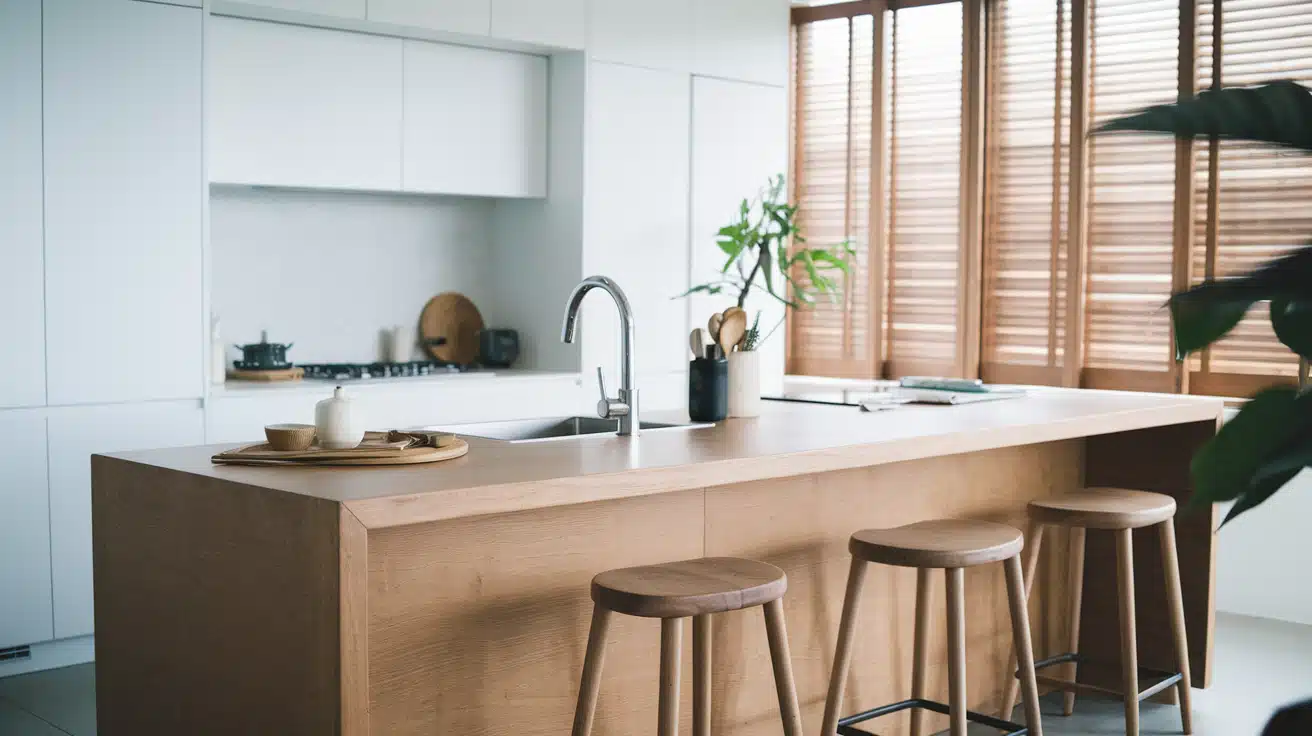
A sleek, simple kitchen island with natural wood accents provides additional storage and workspace. Its minimalist design keeps the kitchen organized and functional.
Key points of this idea:
- Offers extra workspace and storage.
- Maintains a clean, uncluttered look with simple design.
7. Integrate Japanese Paper Lanterns for Soft Lighting
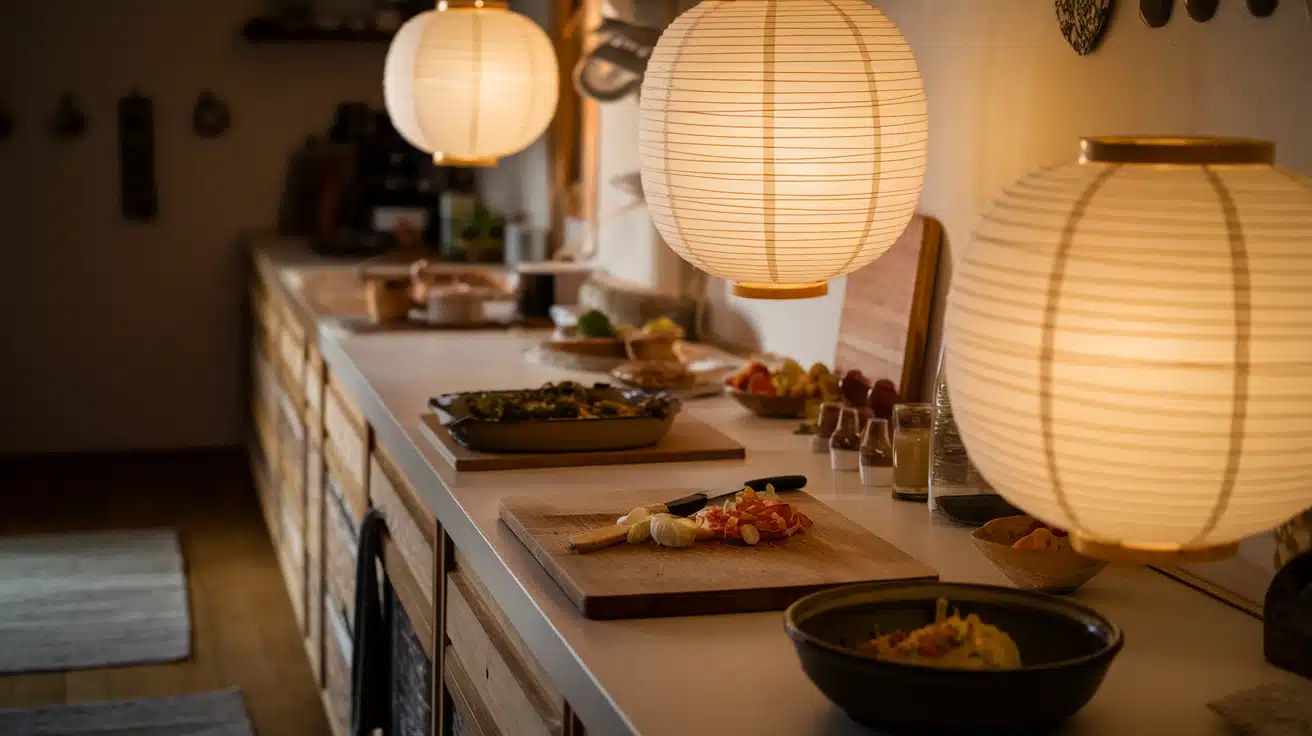
Japanese paper lanterns create soft, ambient lighting that adds warmth and a relaxed atmosphere to the kitchen, enhancing the Japandi feel.
Key points of this idea:
- Provides soft, calming light.
- Adds an authentic touch of Japanese design.
8. Mix Dark Stone Countertops with Light-Colored Cabinets
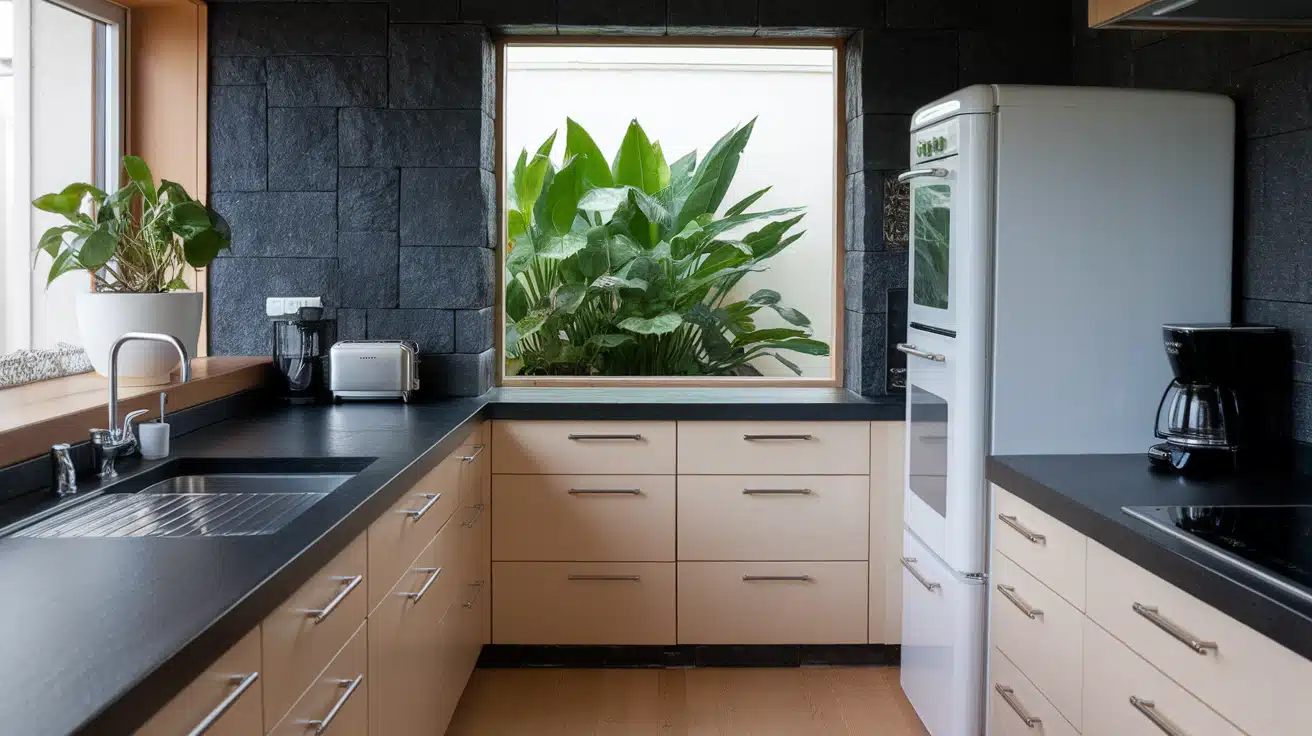
Combining dark stone countertops with light-colored cabinets creates a striking contrast that adds depth while maintaining a balanced, harmonious kitchen design.
Key points of this idea:
- Contrasting colors create visual interest and balance.
- Highlights the natural beauty of stone and wood.
9. Opt for a Concrete or Stone Floor
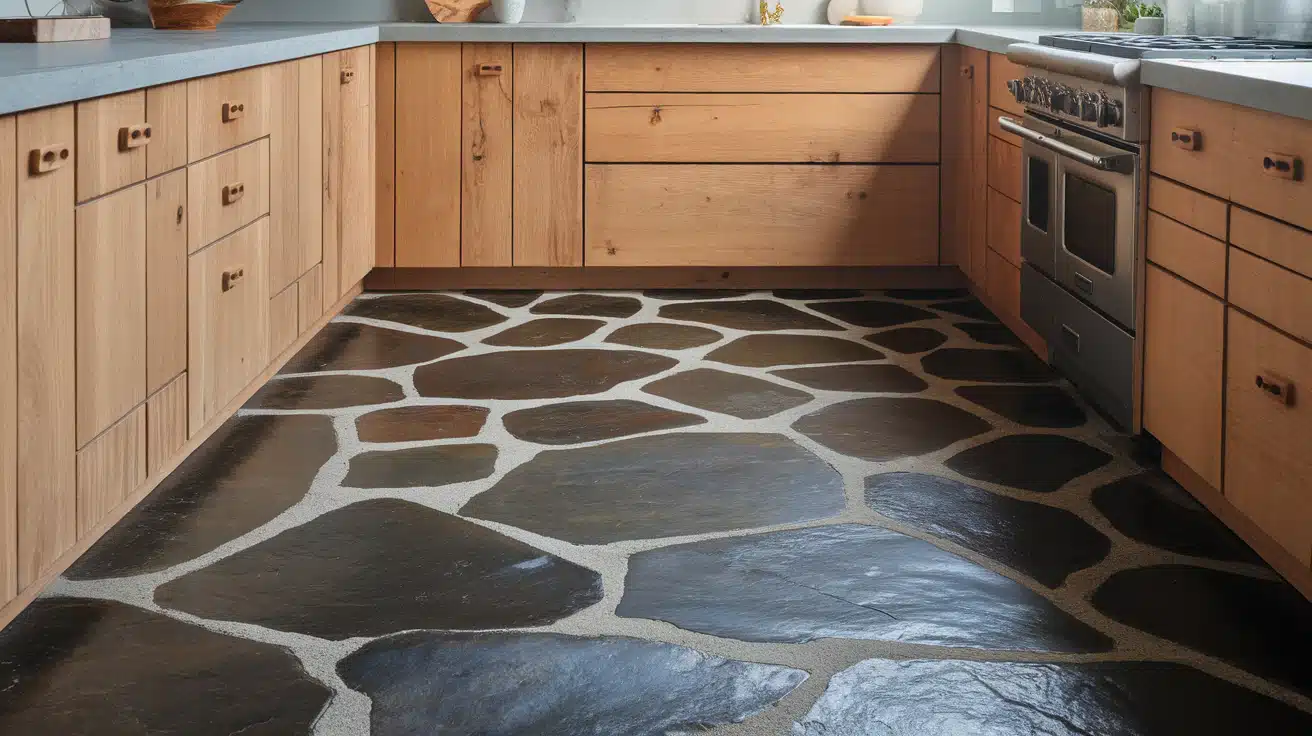
Concrete or stone flooring provides a grounded, industrial touch while complementing the natural materials used in the kitchen. It’s durable and easy to maintain.
Key points of this idea:
- Adds durability and texture to the space.
- Complements natural materials like wood and stone.
10. Paint Cabinetry in Muted Earthy Tones
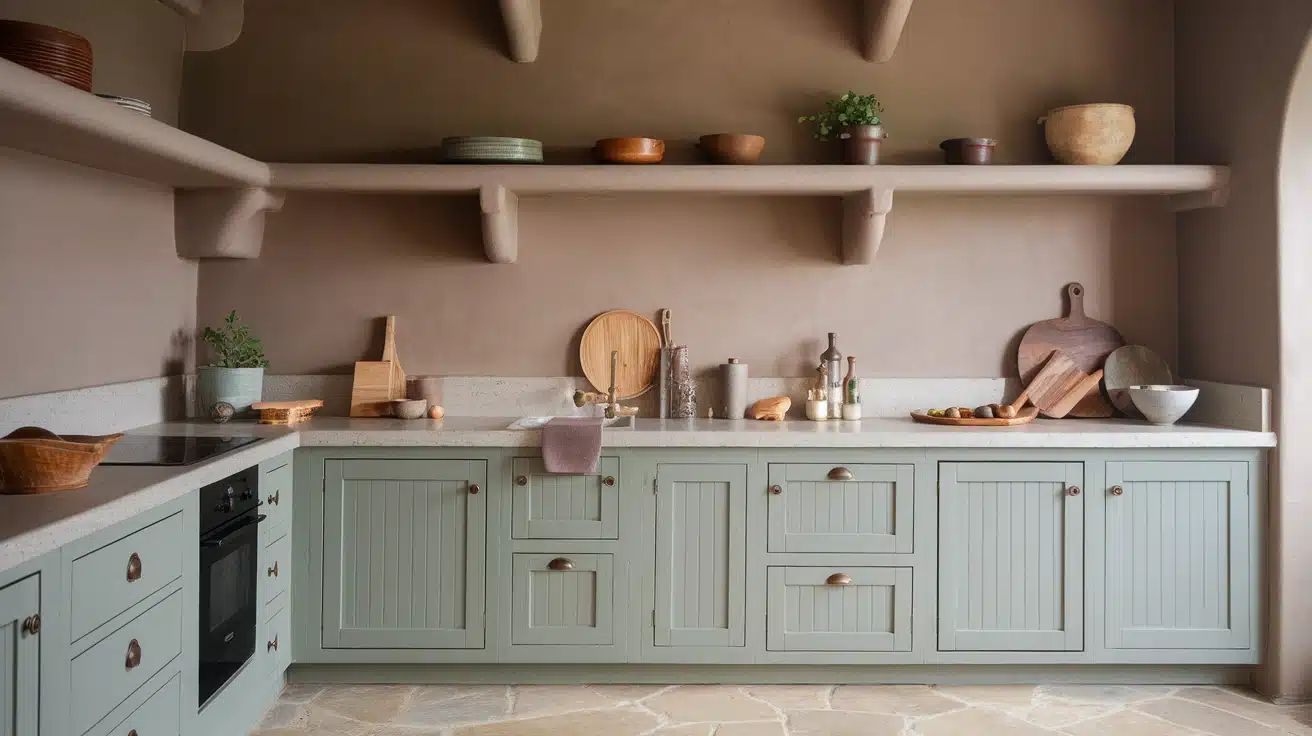
Muted earthy tones like sage, clay, and warm gray provide a calm backdrop for the kitchen, enhancing the natural feel while remaining versatile and easy to pair.
Key points of this idea:
- Adds warmth and depth with earthy tones.
- Versatile and pairs well with natural textures.
11. Place Small Indoor Plants on Countertops
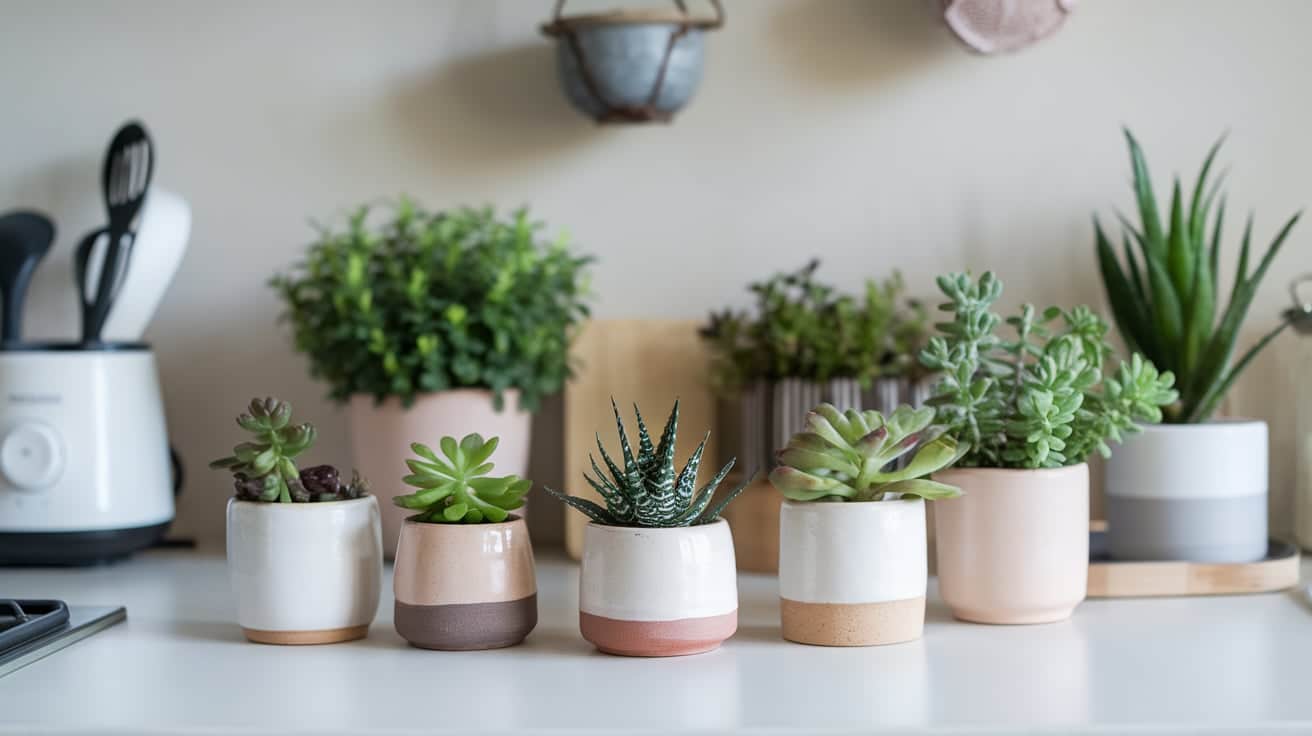
Adding small indoor plants on countertops brings a touch of greenery into the kitchen. It creates a more inviting atmosphere and complements the natural elements in Japandi design.
Key points of this idea:
- Brings freshness and nature indoors.
- Helps in maintaining a balanced, organic kitchen environment.
12. Position a Large, Statement Ceramic Sink
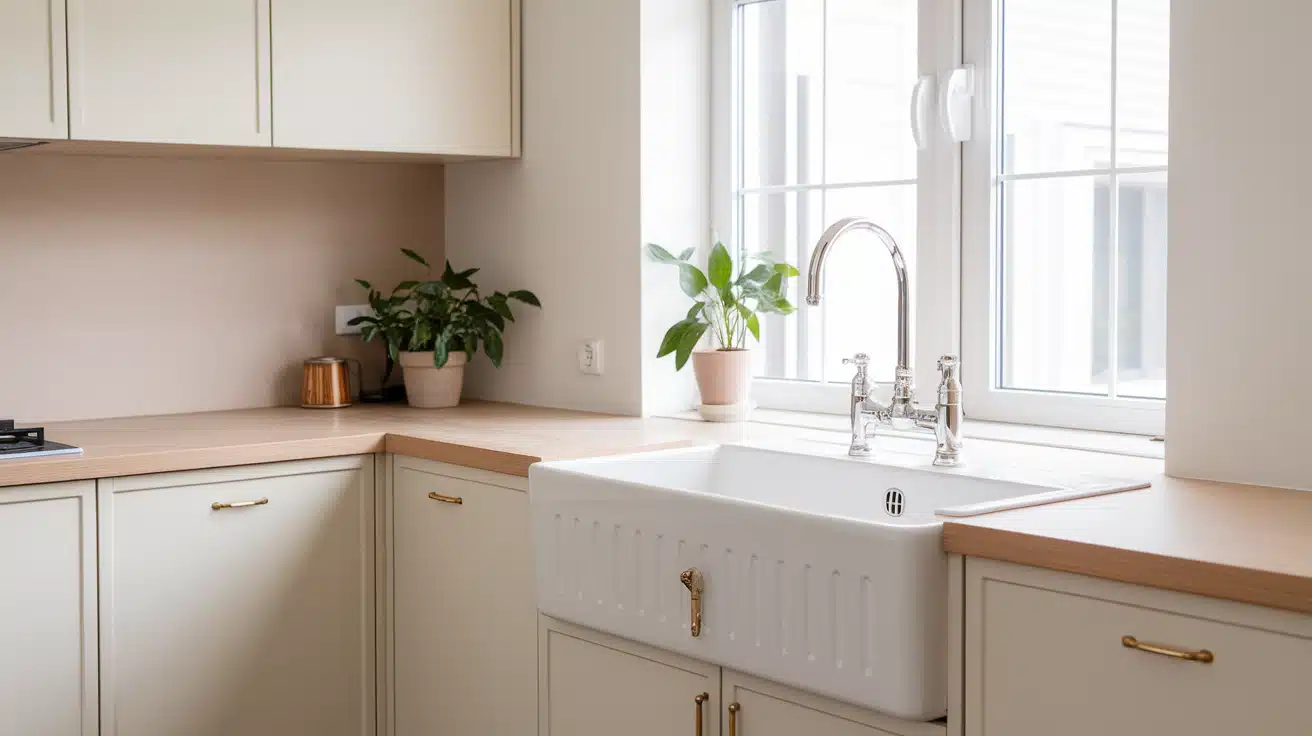
A large, statement ceramic sink becomes a focal point in the kitchen, offering both practicality and style. Its smooth surface is easy to clean and adds a timeless touch to the space.
Key points of this idea:
- Durable and easy to maintain.
- Adds a timeless, classic look to the kitchen.
13. Reimagine Traditional Japanese Wooden Stools
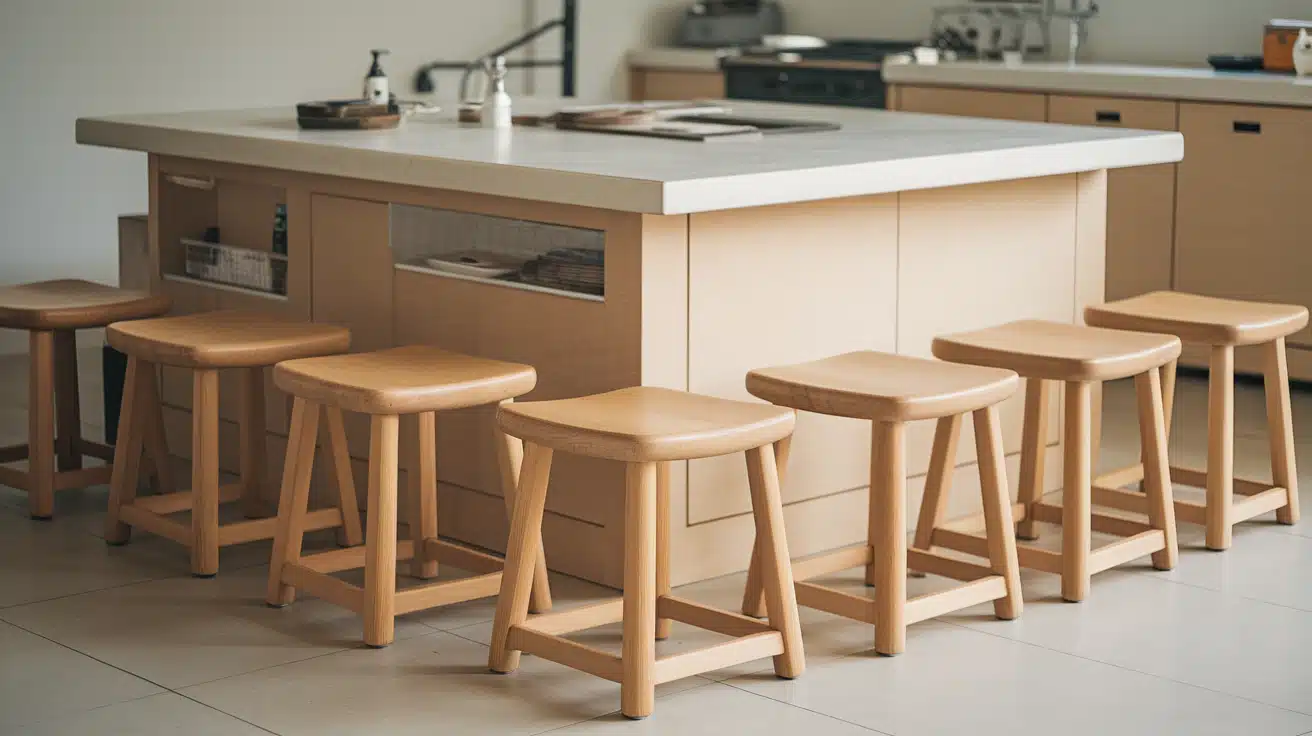
Traditional Japanese wooden stools with simple designs enhance the Japandi style. These stools are practical, lightweight, and can be easily moved around the kitchen for additional seating.
Key points of this idea:
- Simple, functional design that complements the space.
- Lightweight and versatile for seating.
14. Select Bamboo or Rattan Accents
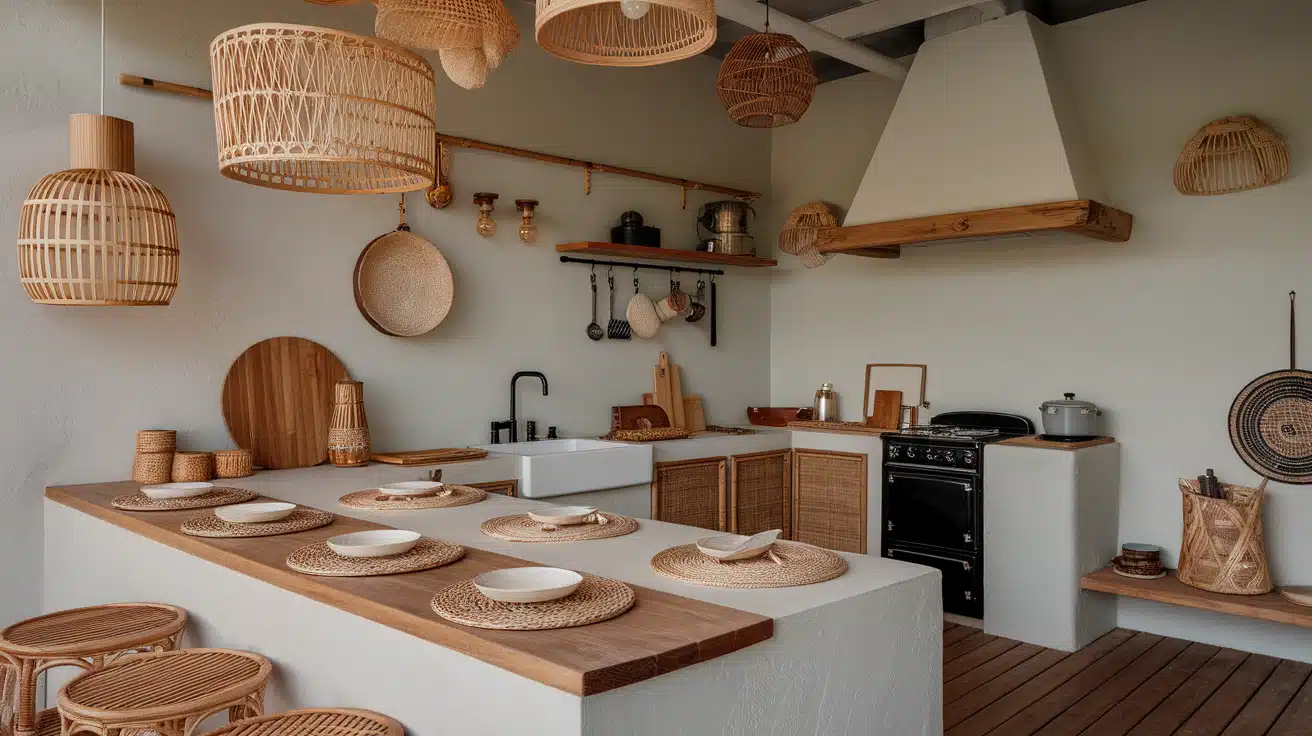
Bamboo or rattan accents bring natural textures into the kitchen. These materials add warmth and are a perfect fit for the Japandi style, which focuses on sustainability and simplicity.
Key points of this idea:
- Adds a natural, earthy feel to the space.
- Works well with both modern and traditional materials.
15. Set Up a Minimalist Coffee Nook
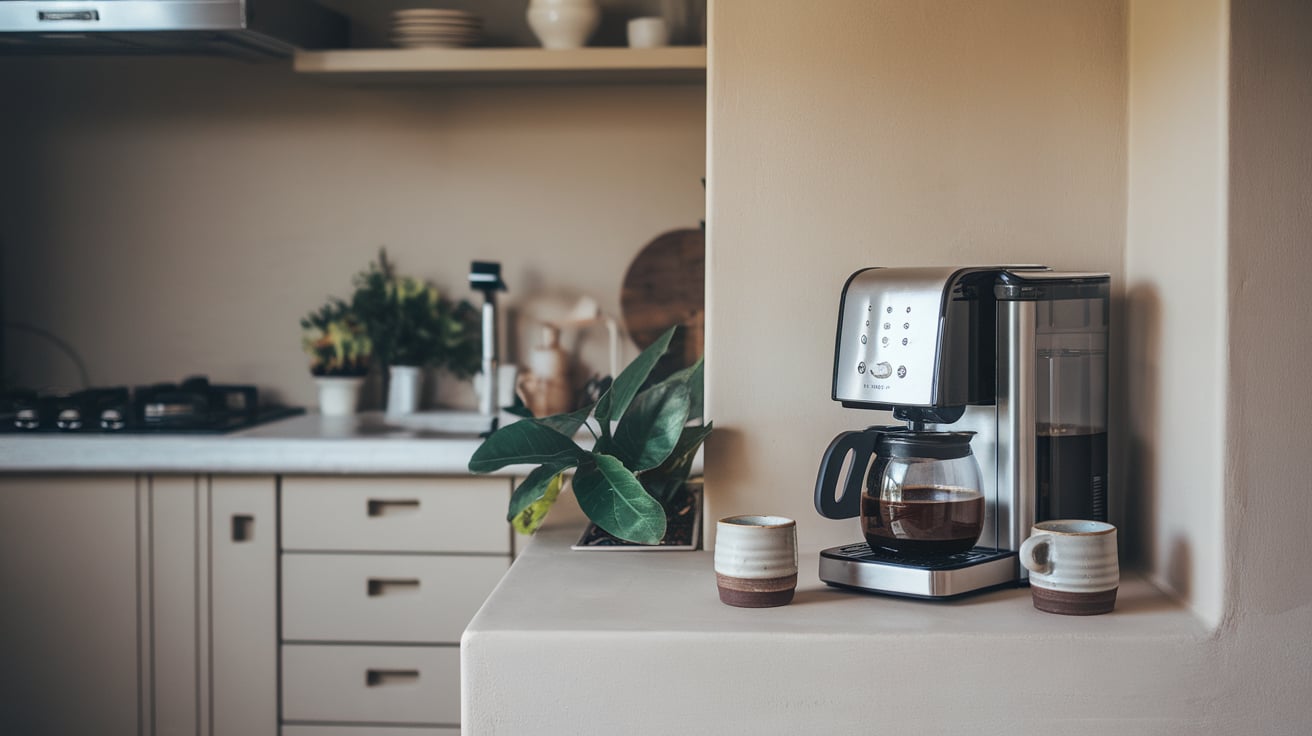
A minimalist coffee nook with clean lines and neutral tones offers a quiet, organized space for enjoying coffee. This nook can include sleek countertops and a simple coffee maker for functionality.
Key points of this idea:
- Provides a compact, dedicated coffee space.
- Keeps the kitchen organized with a minimalist design.
16. Showcase Minimalist Tableware
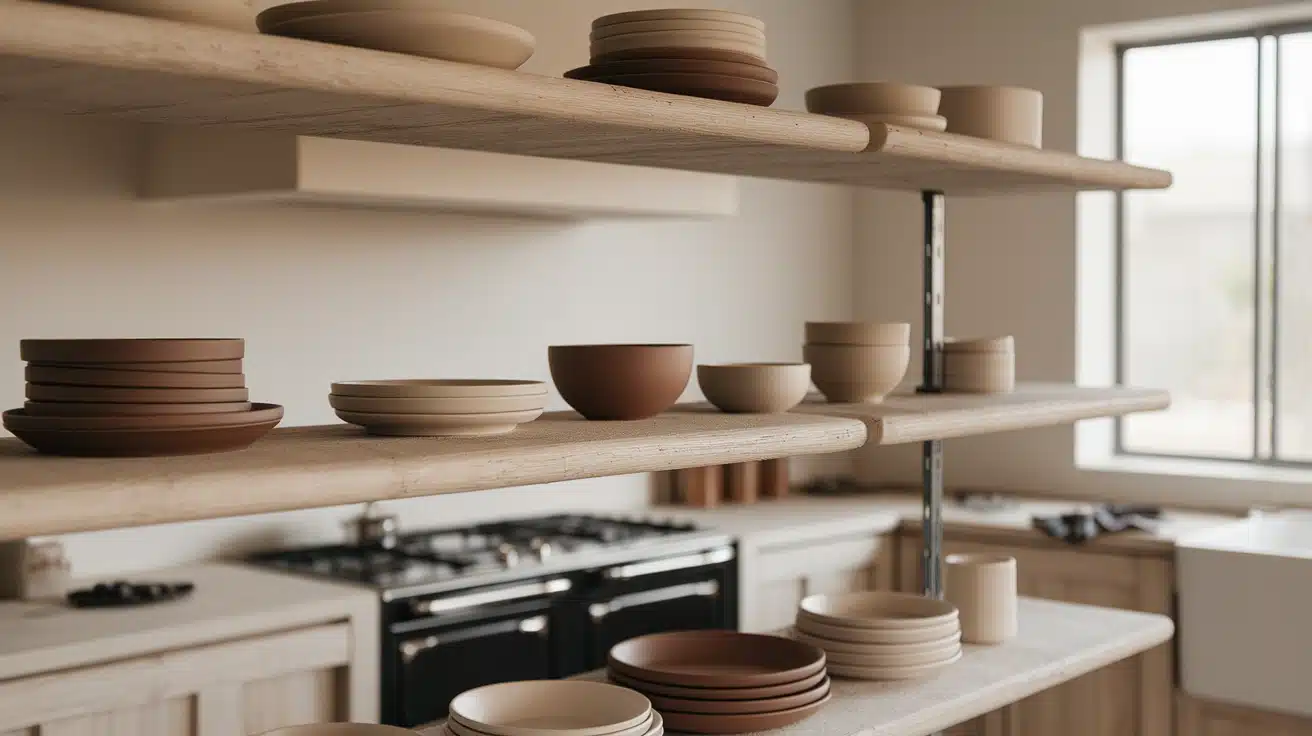
Displaying minimalist tableware, such as simple ceramic plates and bowls, enhances the clean, functional design of the kitchen. These items should be subtly decorative and easy to access.
Key points of this idea:
- Keeps tableware on display for easy access.
- Minimalist design adds grace without clutter.
17. Choose Matte Finishes for All Hardware
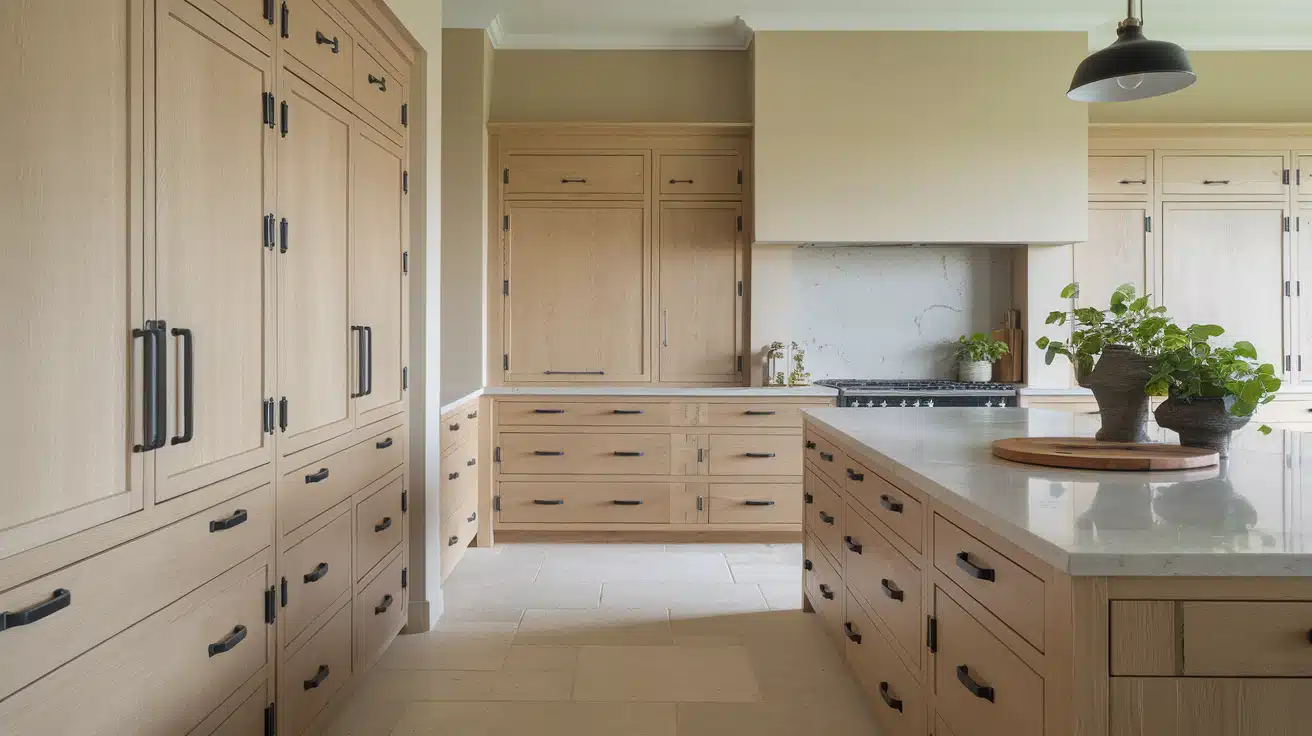
Opting for matte finishes for handles, faucets, and other hardware creates a subtle yet refined look. This finish reduces the shine of metal, contributing to the serene, understated essence of Japandi kitchens.
If you’re selecting fixtures and unsure where to begin, this helpful guide to kitchen tapware can walk you through styles and finishes that match Japandi’s calm and minimal aesthetic.
Key points of this idea:
- Subtle matte finishes enhance the simplicity of the design.
- Reduces glare and adds a modern touch to kitchen fixtures.
18. Use Natural Stone Materials for Countertops
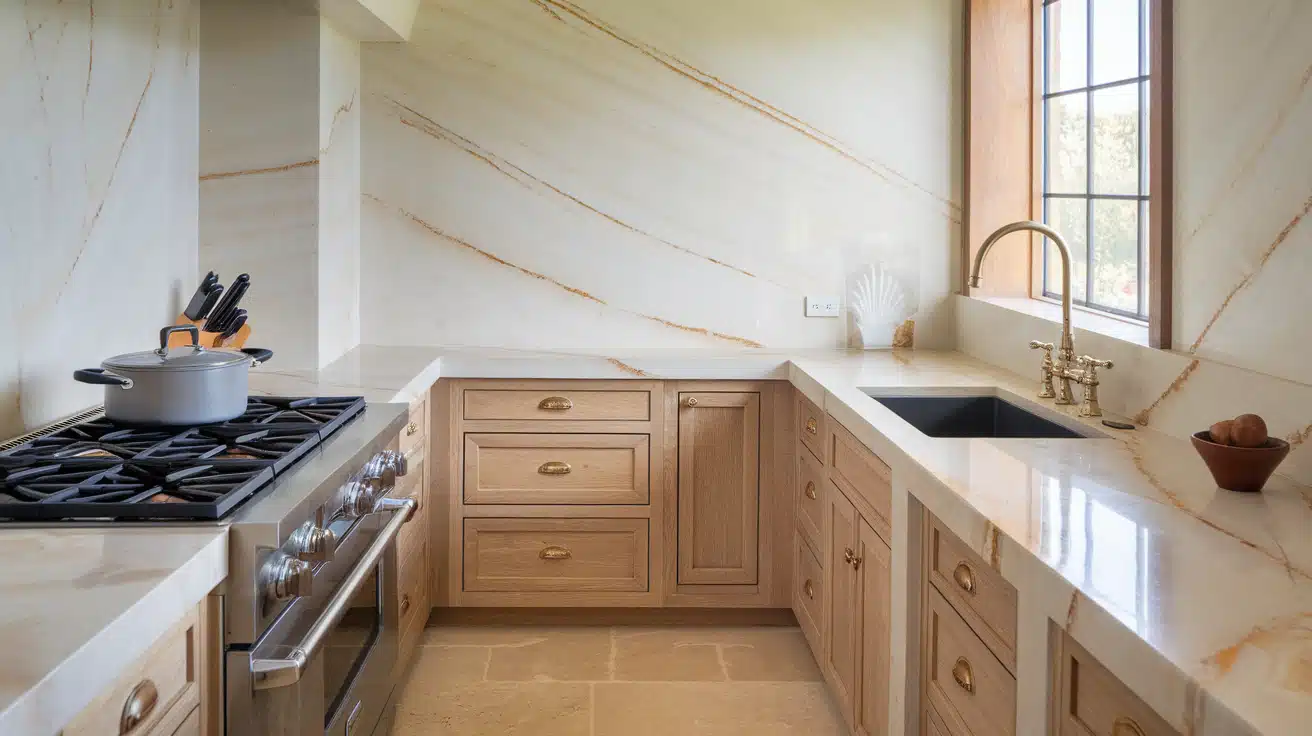
Natural stone countertops, like marble or granite, add texture and durability to the kitchen. These materials combine functionality with a timeless design that fits flawlessly in Japandi interiors.
Key points of this idea:
- Natural stone provides durability and timeless beauty.
- Works well with both warm and neutral kitchen tones.
19. Incorporate Sliding Doors for Flawless Flow
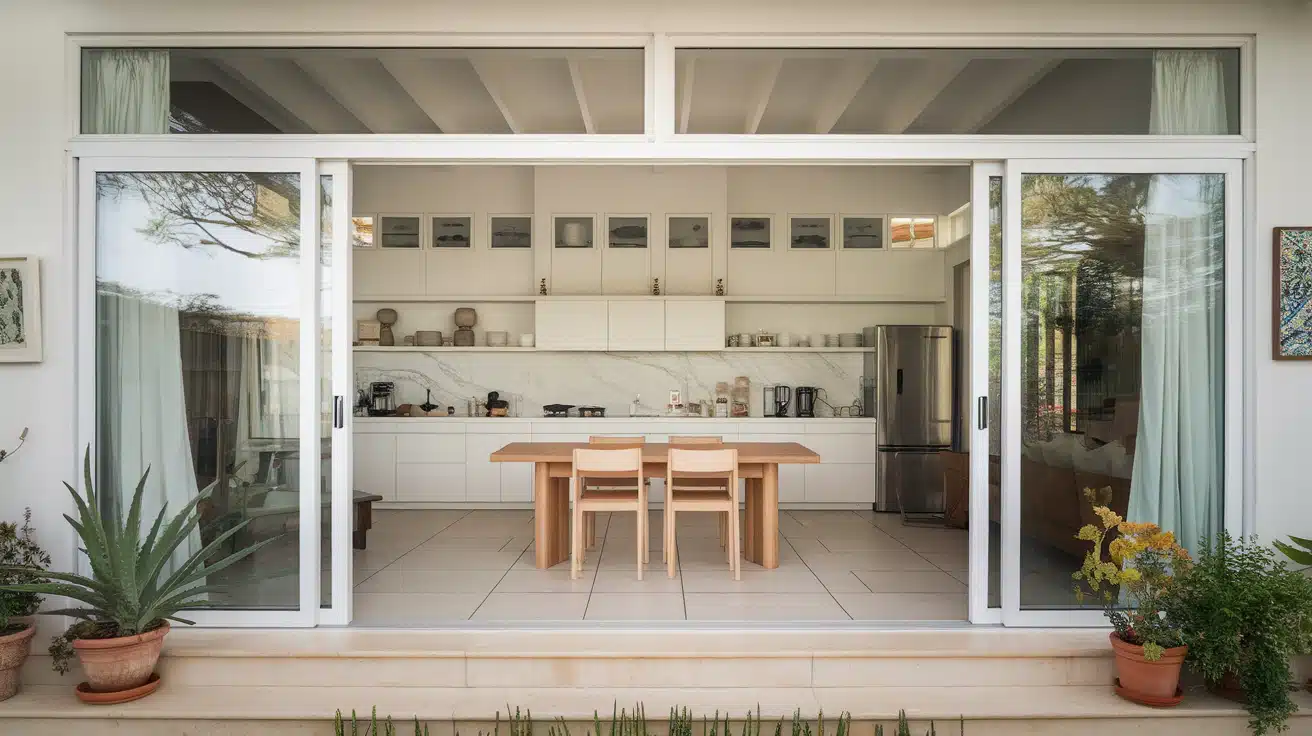
Sliding doors create an open, transition between the kitchen and dining or living area. They save space while adding a clean, minimalist look that aligns with Japandi principles.
Key points of this idea:
- Saves space while providing an open, connected layout.
- Offers a sleek, minimalistic design.
20. Add Open Storage Above the Counter
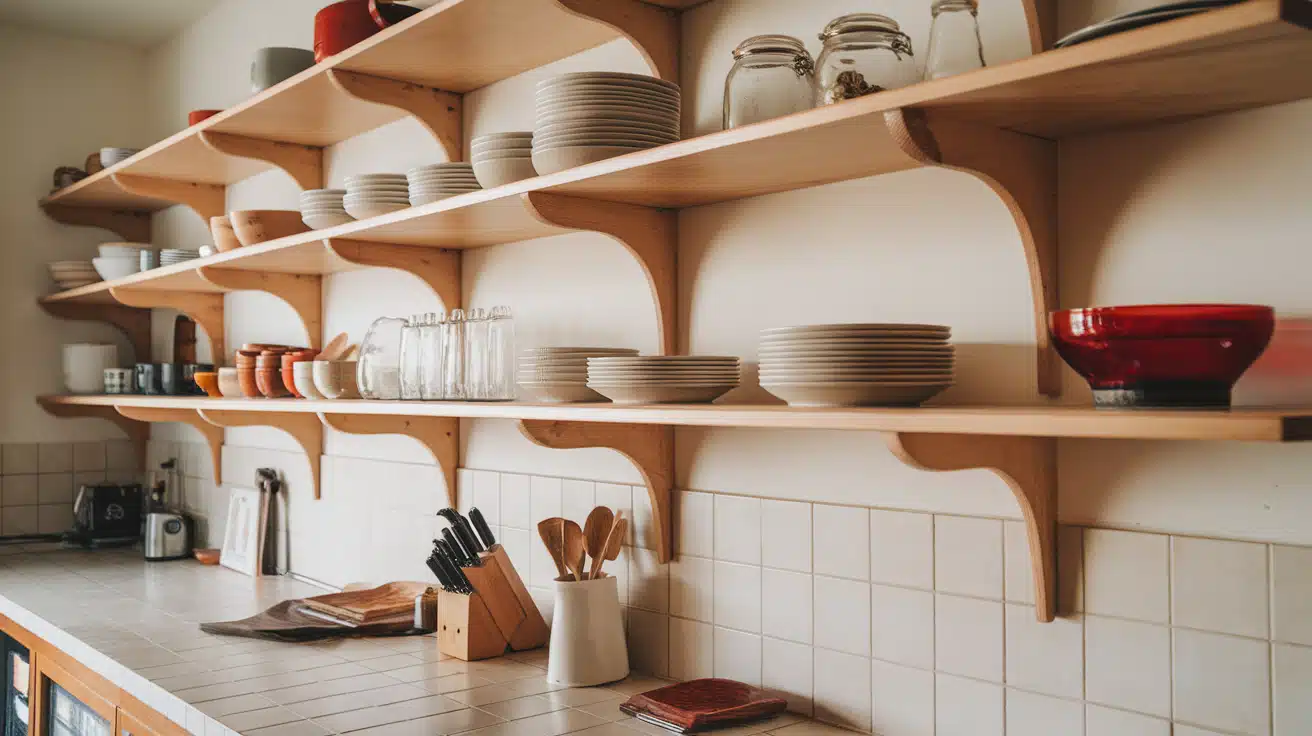
Open storage above the counter creates a light, airy feel in the kitchen. It allows for easy access to kitchen essentials while maintaining a clean and uncluttered look.
Key points of this idea:
- Provides easy access to frequently used items.
- Maintains an organized, open design by reducing clutter.
21. Combine a Neutral-Colored Sink with a Wooden Countertop
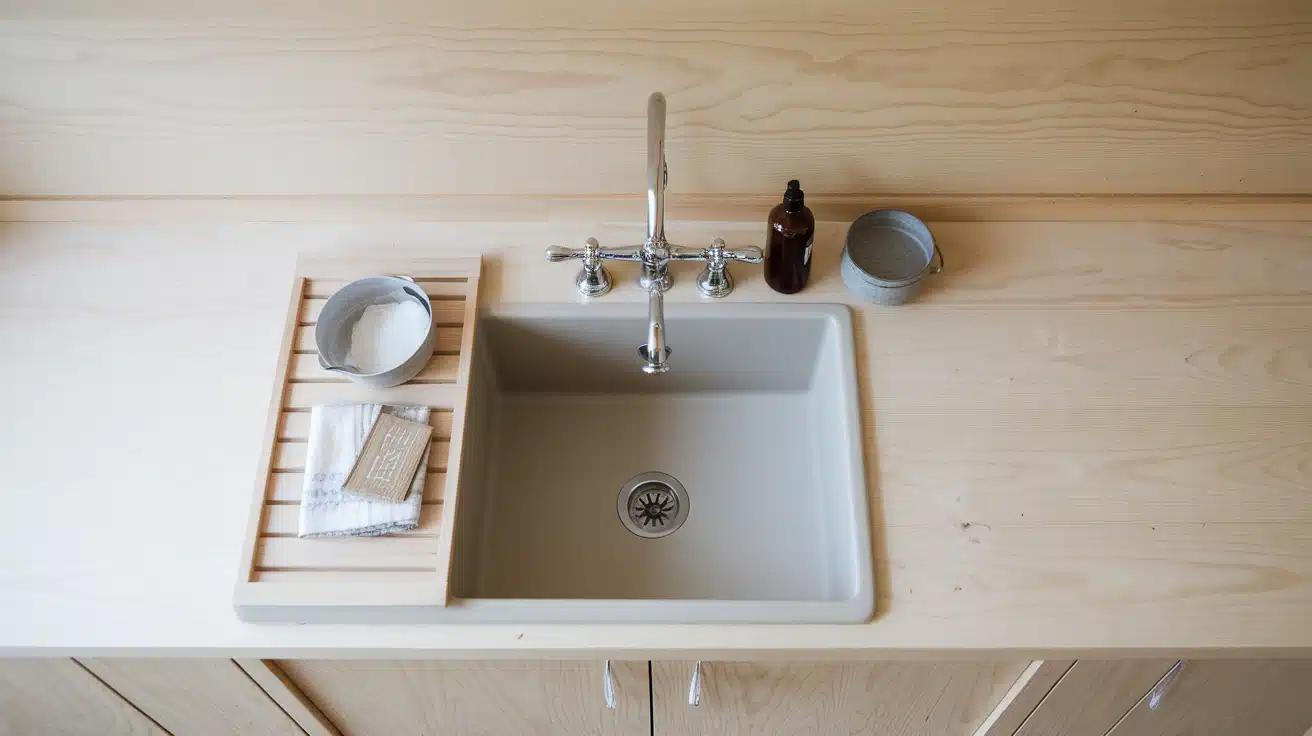
Pairing a neutral-colored sink with a wooden countertop adds warmth and balance to the kitchen. The combination of soft sink tones with the rich texture of wood creates a harmonious look.
Key points of this idea:
- Neutral tones create a calm, balanced look.
- Wooden countertop adds warmth and natural texture.
22. Design a Hidden Pantry with Sliding Doors
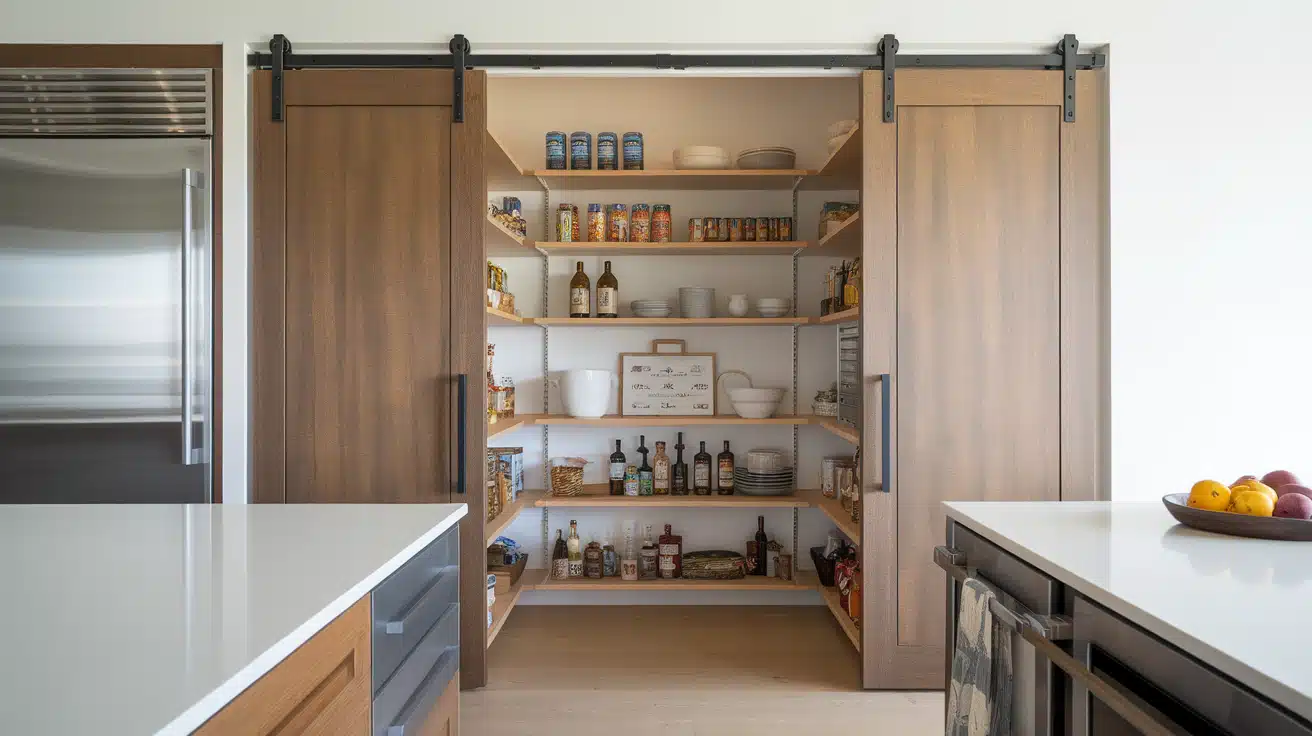
A hidden pantry with sliding doors keeps kitchen essentials out of sight while maintaining a clean and minimalist kitchen design. This helps maximize space while keeping the kitchen neat and organized.
Key points of this idea:
- Keeps items neatly tucked away, reducing clutter.
- Sliding doors save space and maintain a minimalist look.
23. Choose Glass-Front Cabinets for Displaying Tableware
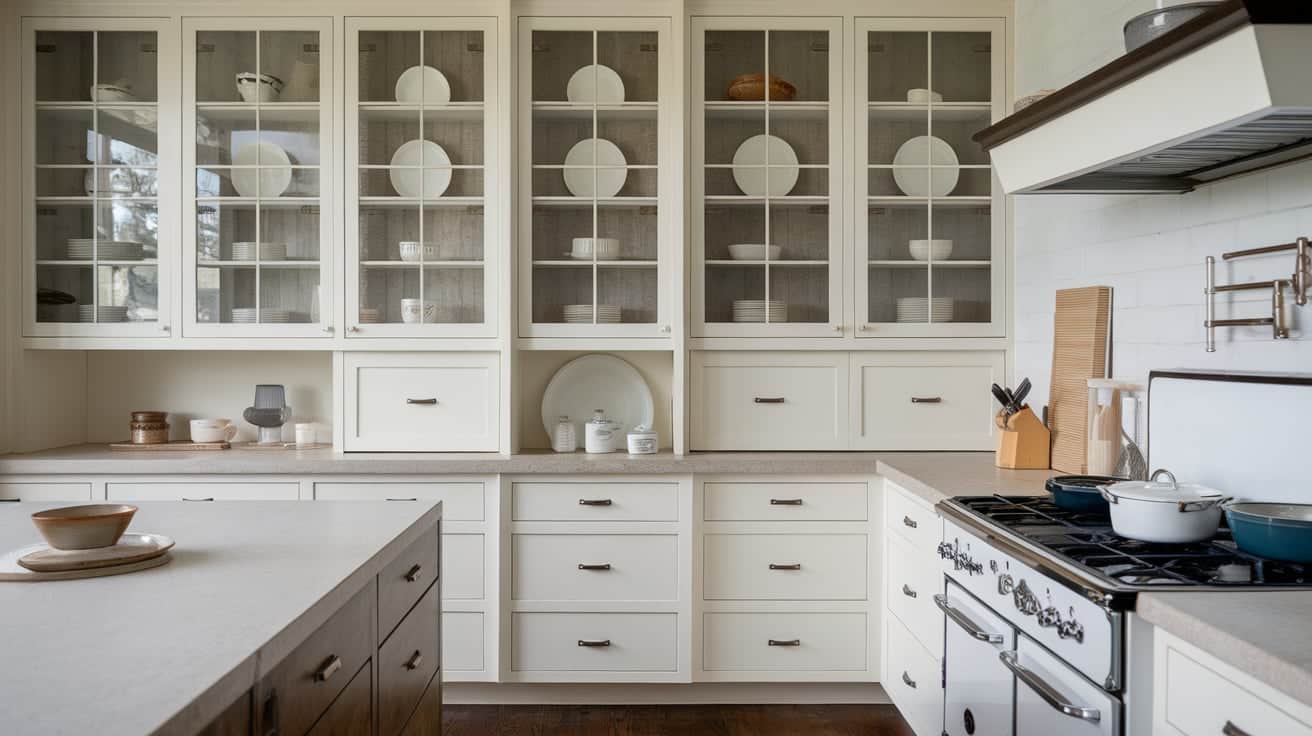
Glass-front cabinets allow for the display of minimalist tableware, showcasing simple ceramics and delicate pieces. This design keeps the kitchen open and organized while providing a touch of classiness.
Key points of this idea:
- Offers storage and display space for kitchen items.
- Keeps the kitchen looking organized and open.
24. Create a Monochromatic Color Scheme
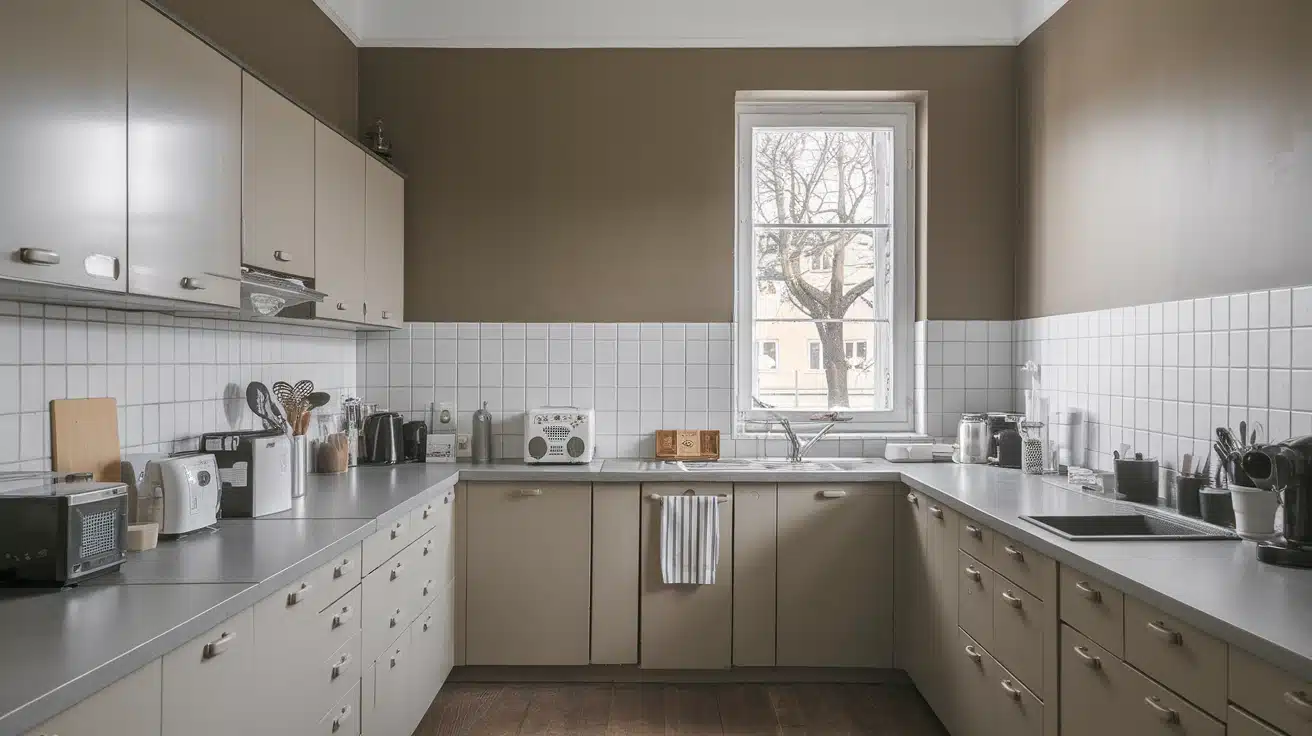
Using a monochromatic color scheme in the kitchen helps create a sleek, uniform look. Shades of gray or beige can be used for cabinetry, countertops, and walls to keep the space calm and cohesive.
Key points of this idea:
- Ensures a streamlined, uniform look throughout the space.
- Works well with various natural materials for texture and contrast.
25. Use Wooden Cabinetry with Visible Grains
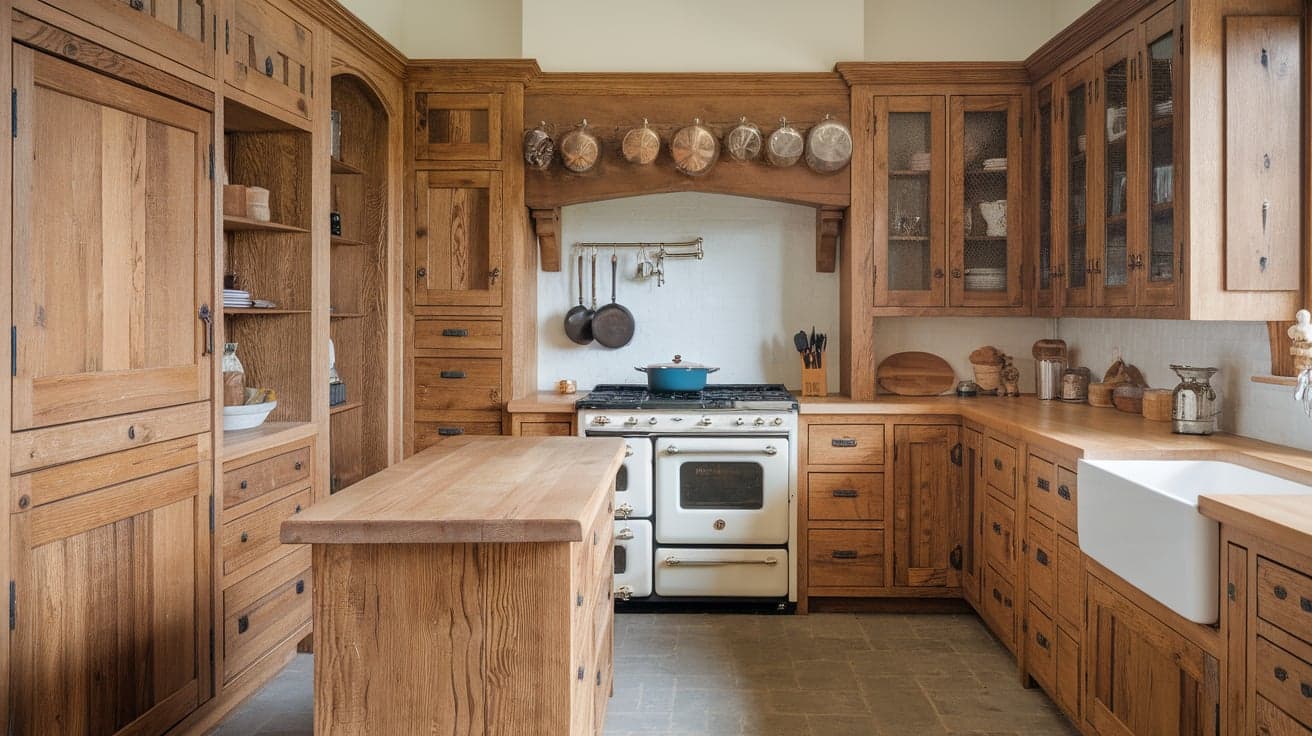
Wooden cabinetry with visible grains enhances the organic feel of a Japandi kitchen. The natural texture of the wood adds character and warmth while maintaining a clean, minimalist design.
Key points of this idea:
- Visible grain adds natural beauty and texture.
- Pairs well with neutral tones and natural materials.
26. Opt for a Functional, Integrated Design
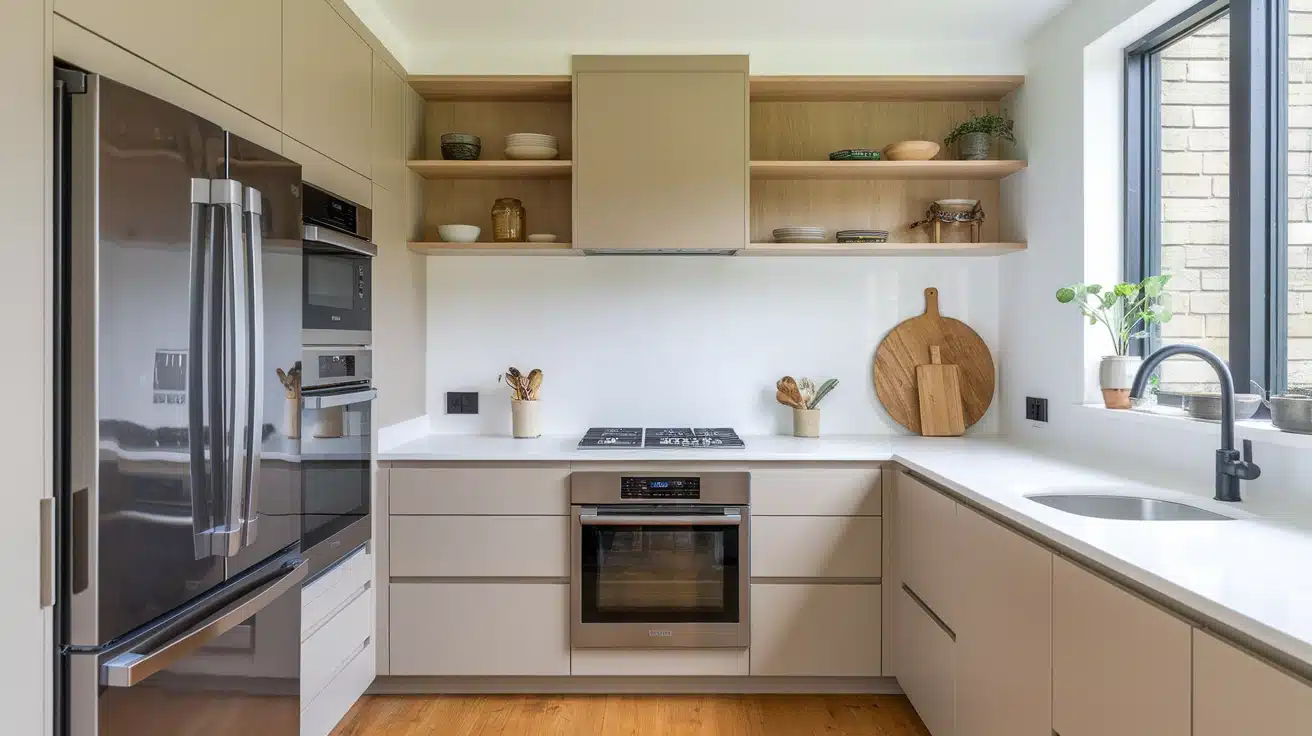
An integrated kitchen design features built-in appliances and smooth cabinetry to create a streamlined, modern look. This style reduces visual clutter and enhances the minimalist appeal.
Key points of this idea:
- Offers a clean, uncluttered look.
- Built-in appliances maximize space and functionality.
27. Place a Woven Rug Under the Dining Table
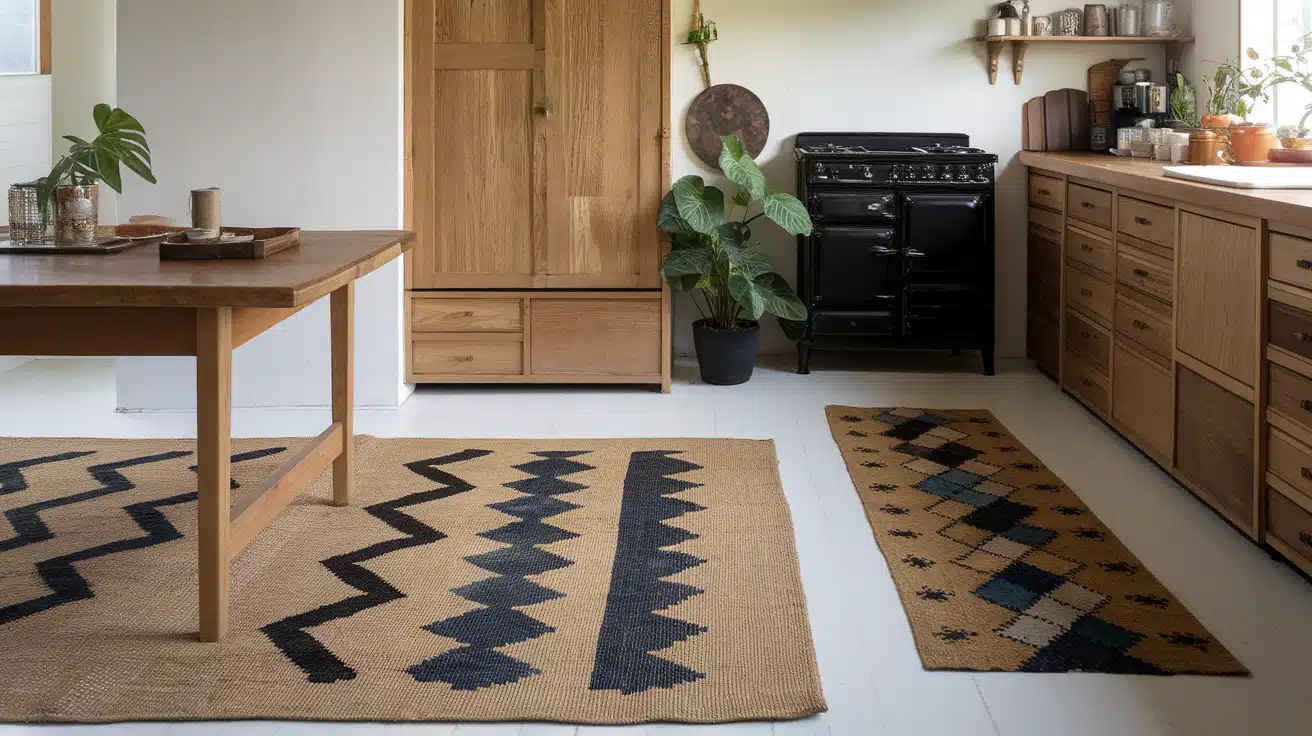
A woven rug under the dining table adds texture and warmth to the kitchen-dining area. This simple addition helps define the space while contributing to a cozy atmosphere.
Key points of this idea:
- Adds warmth and texture to the dining area.
- Helps define the kitchen-dining space with simple design.
28. Set Up a Modern Tea Station
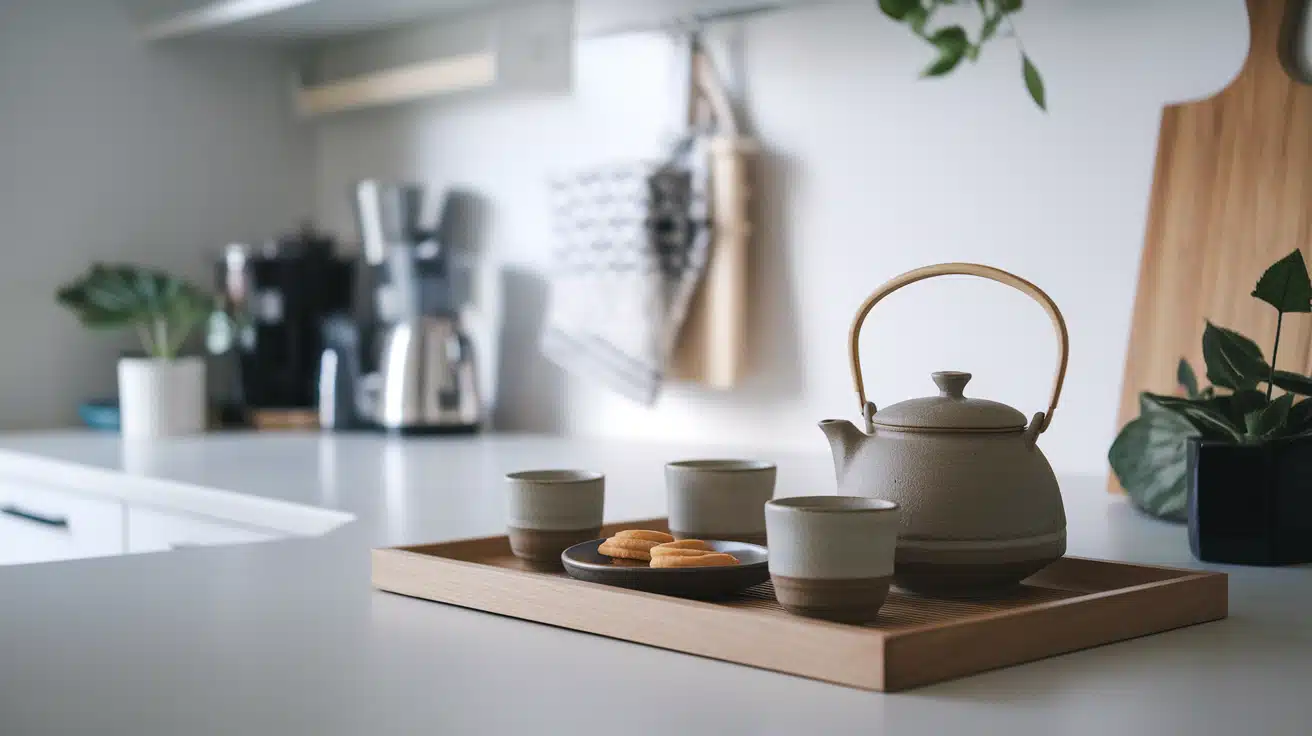
A modern tea station with a Japanese tea pot, cups, and minimalist accessories creates a dedicated space for tea rituals. This simple setup aligns with Japandi style, which values mindful living and simplicity.
Key points of this idea:
- Encourages a mindful, relaxing tea experience.
- Simple, functional design that fits well in a Japandi kitchen.
29. Add a Deep, Contrasting Navy-Blue Accent Wall
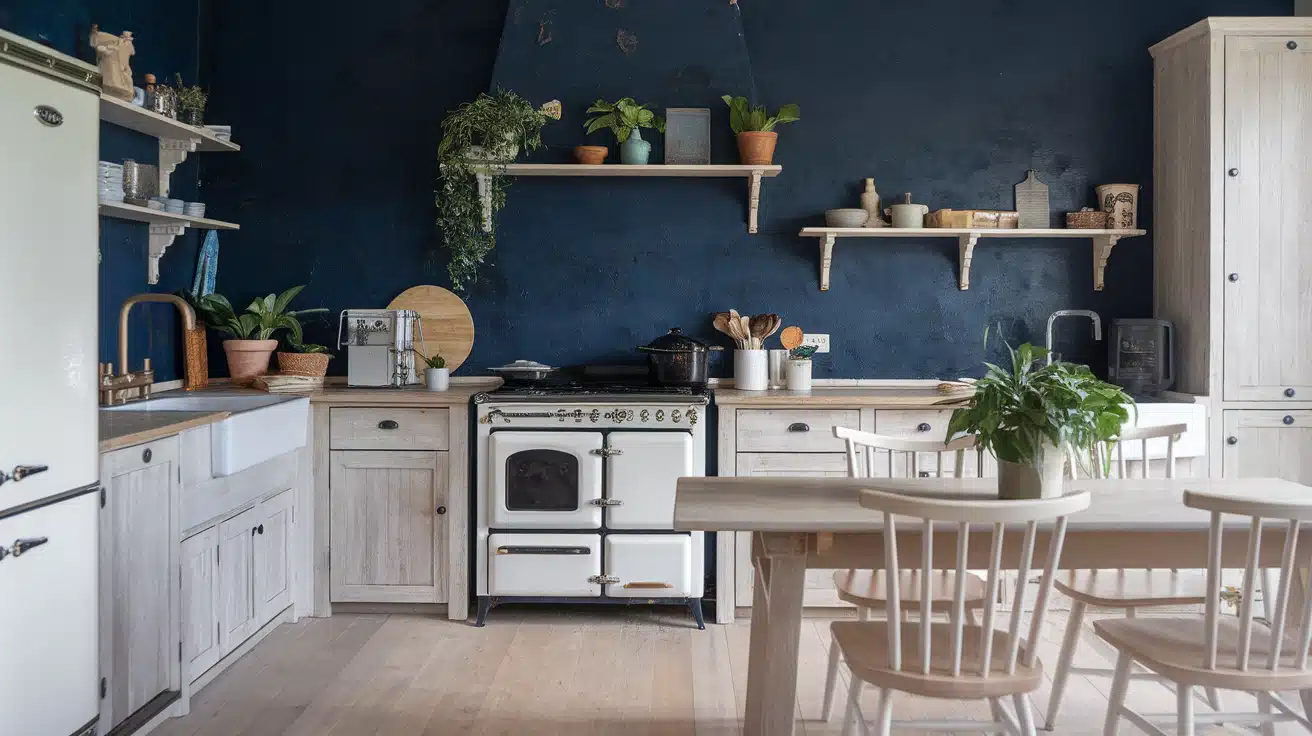
A deep navy-blue accent wall adds bold contrast while keeping the overall kitchen design grounded and serene. It works well with natural wood tones and neutral-colored elements.
Key points of this idea:
- Creates a strong contrast with natural materials.
- Adds depth and visual interest to the space.
30. Go for an Asymmetrical Kitchen Layout
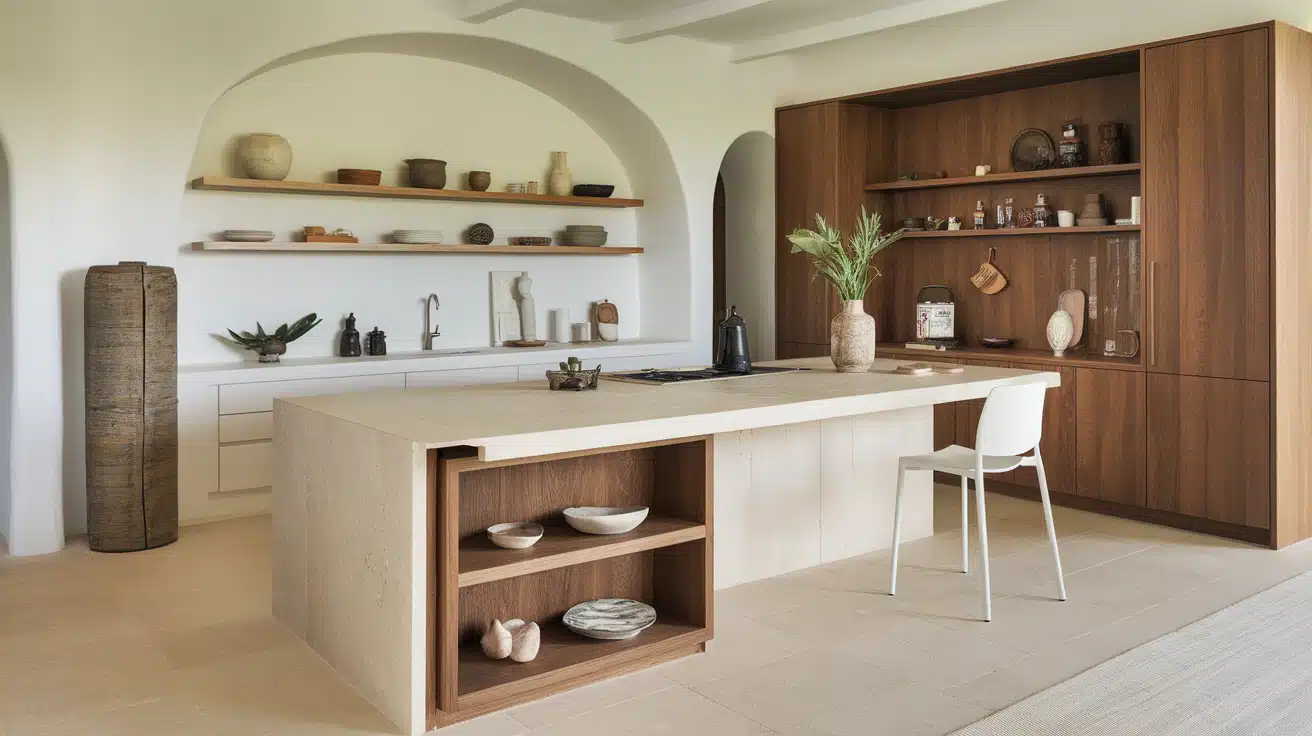
An asymmetrical layout breaks traditional design rules to create a more adaptable kitchen. It adds interest and creativity while maintaining functionality and simplicity.
Key points of this idea:
- Creates a unique and creative kitchen layout.
- Maintains a clean, functional design despite the asymmetry.
31. Choose a Wooden Butcher Block for Food Preparation
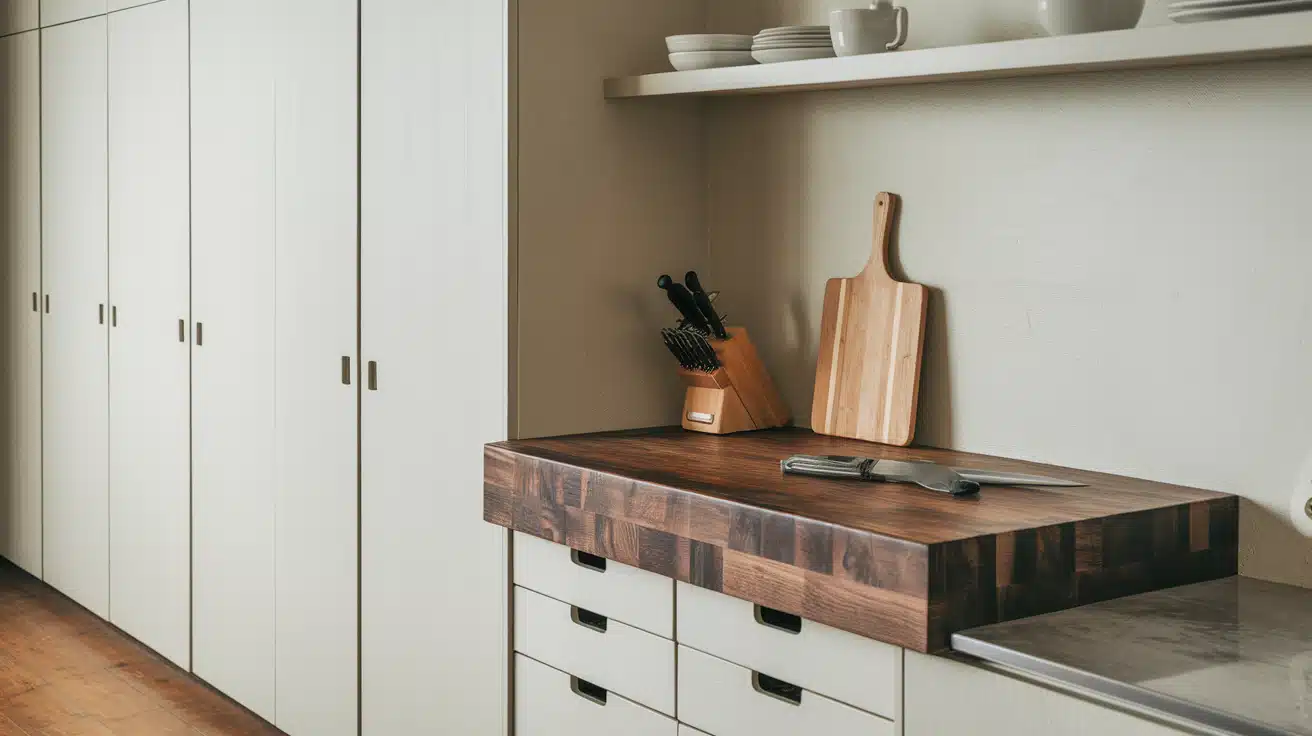
A wooden butcher block provides a durable and visually appealing surface for food prep. It brings warmth and a natural touch to the kitchen while being functional and easy to maintain.
Key points of this idea:
- Adds a natural, organic element to the kitchen.
- Provides a durable and easy-to-maintain workspace for food prep.
32. Install a Low-Profile Hood
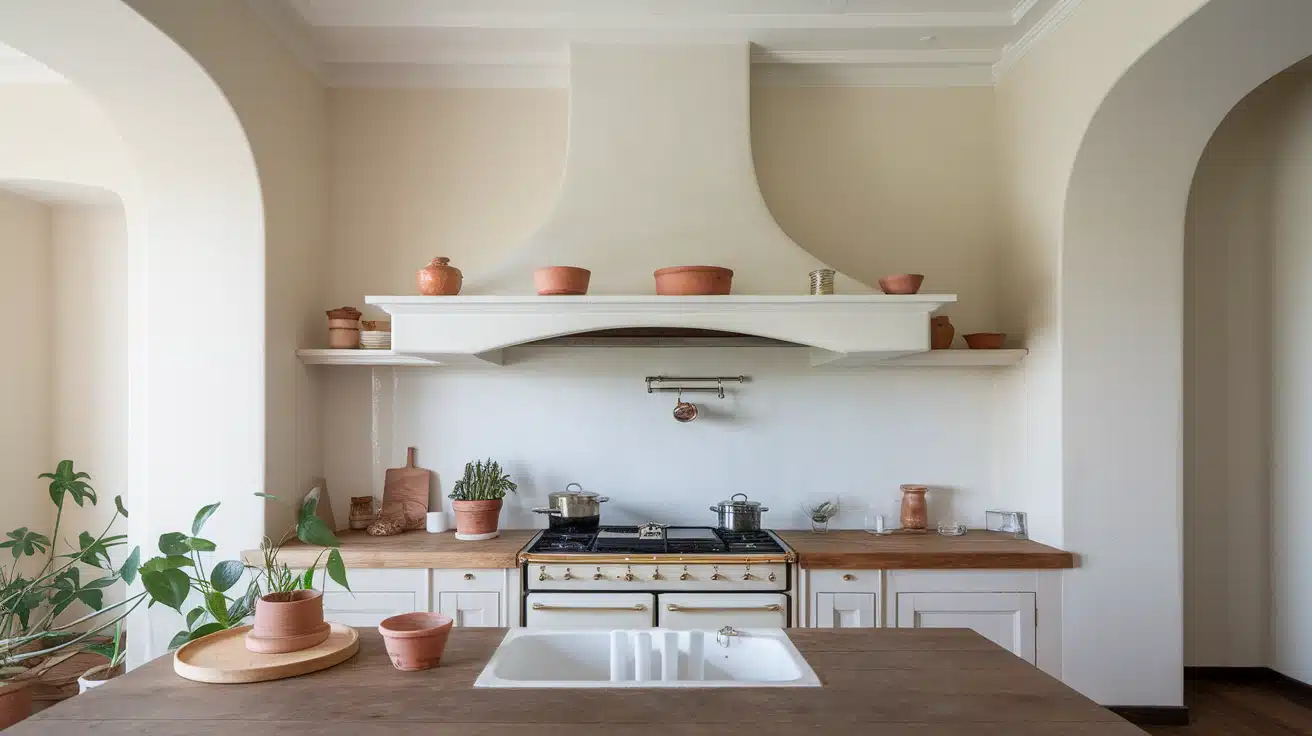
A low-profile range hood blends into the kitchen design. It offers efficient ventilation without drawing too much attention, keeping the focus on the minimalist features of the kitchen.
Key points of this idea:
- Maintains a clean, unobtrusive look.
- Provides effective ventilation while keeping the design sleek.
33. Use Open Shelving for Decorative and Functional Items
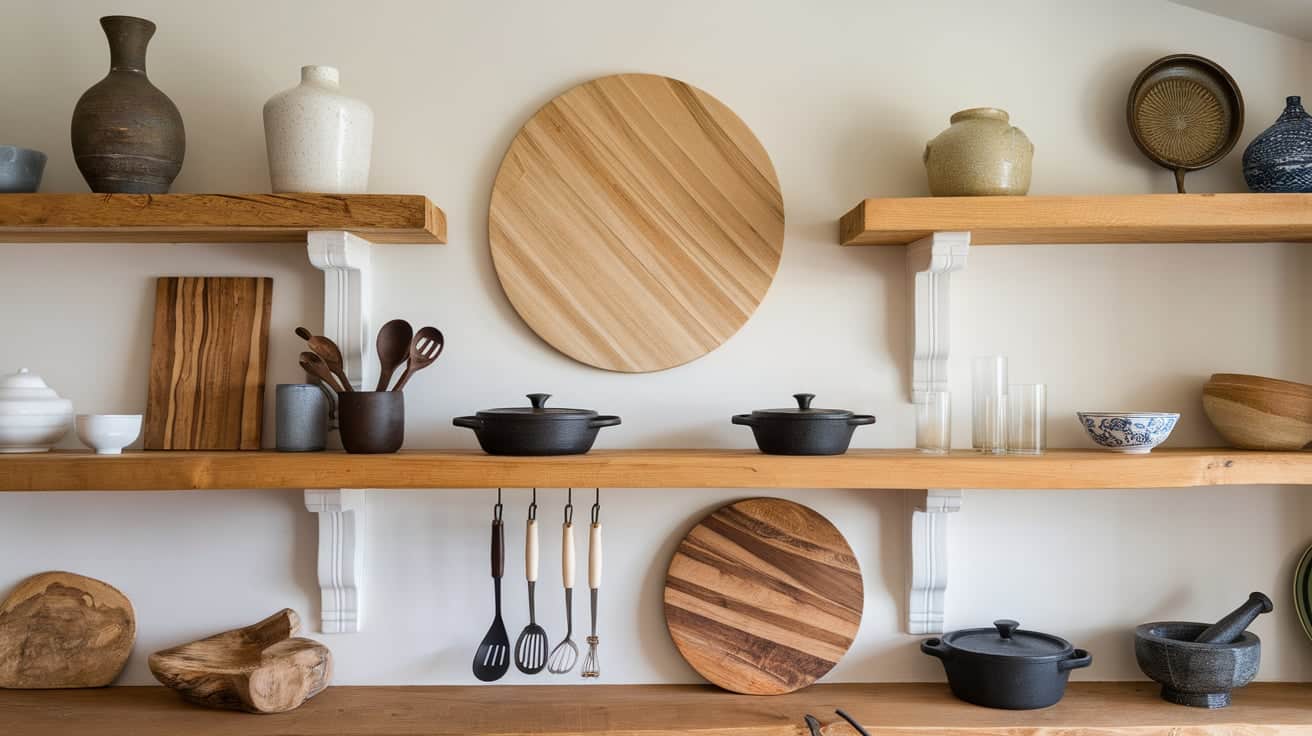
Open shelving allows for both decorative and practical kitchen items to be displayed. This design choice promotes easy access to everyday items while also showcasing beautiful kitchenware.
Key points of this idea:
- Displays both decorative and functional items.
- Keeps the kitchen organized while adding charm.
34. Traditional Japanese Craftsmanship with Modern Simplicity
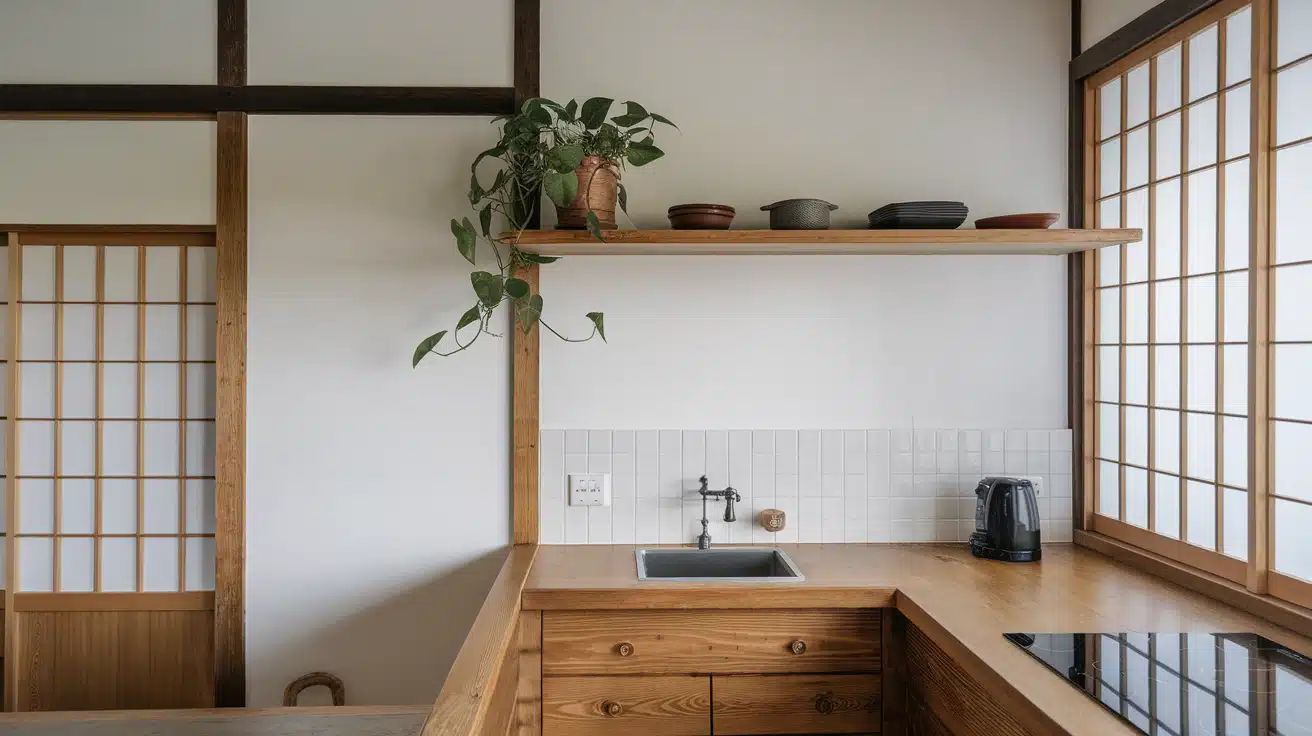
Integrating traditional Japanese craftsmanship with modern design elements creates a timeless look. Simple wooden furniture and functional decor pieces reflect the Japandi philosophy of simplicity and nature.
Key points of this idea:
- Blends traditional Japanese design with modern elements.
- Highlights craftsmanship and functionality.
35. Display Decorative Wooden Bowls
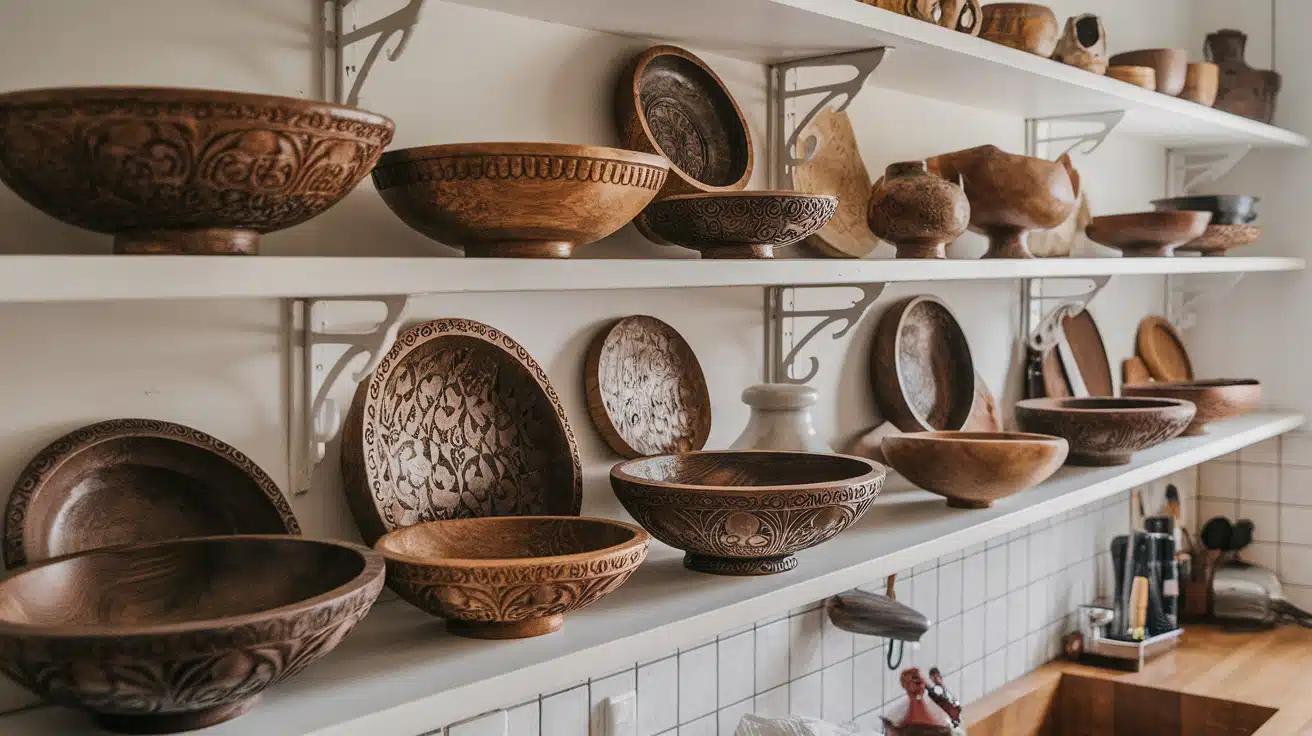
Wooden bowls are functional and decorative, perfect for adding a natural touch to the kitchen. They can be used for both serving food and as decorative accents on countertops or shelves.
Key points of this idea:
- Adds texture and warmth to the space.
- Serves both practical and decorative purposes.
36. Include a High-End, Minimalist Range Hood
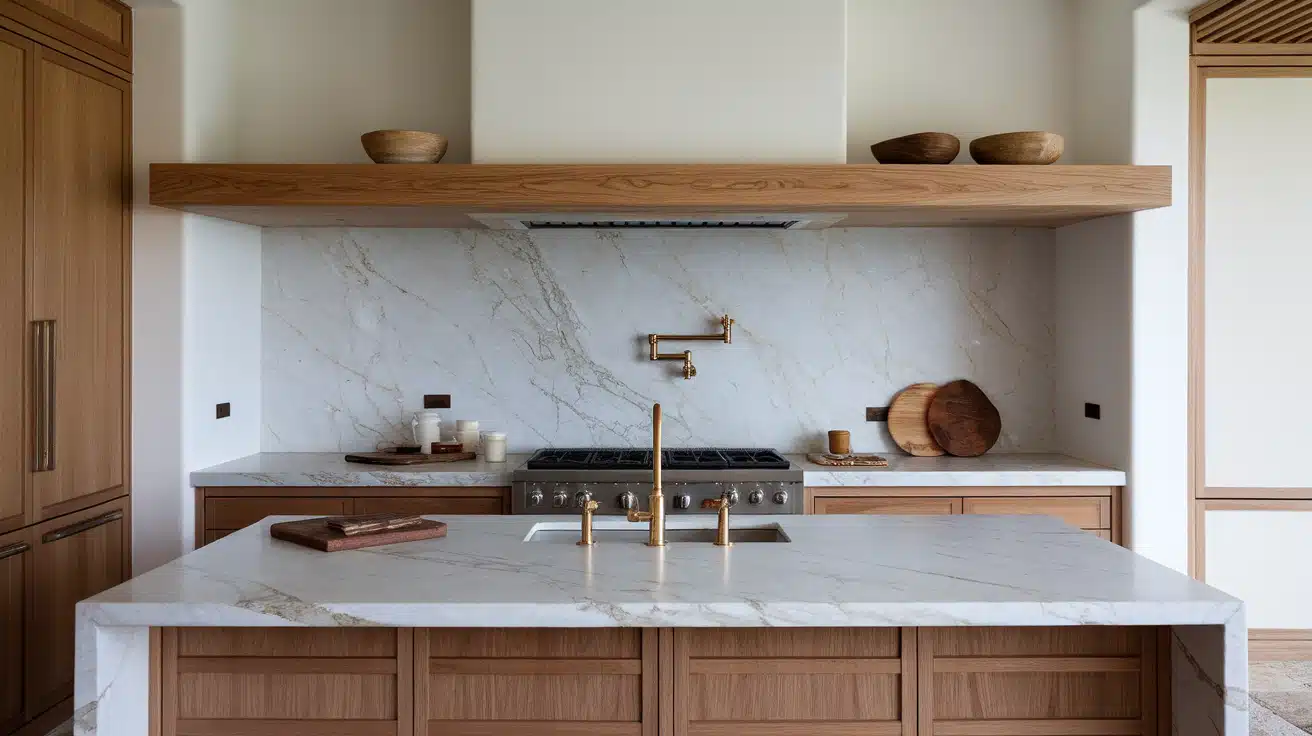
A minimalist range hood adds an efficient yet stylish touch to the kitchen. It’s sleek and modern and blends with the overall kitchen design, maintaining a clean and simple look.
Key points of this idea:
- Offers high performance with a minimalist design.
- Complements modern, functional kitchen elements.
37. Set Up Ambient, Warm Lighting Using Paper Lanterns
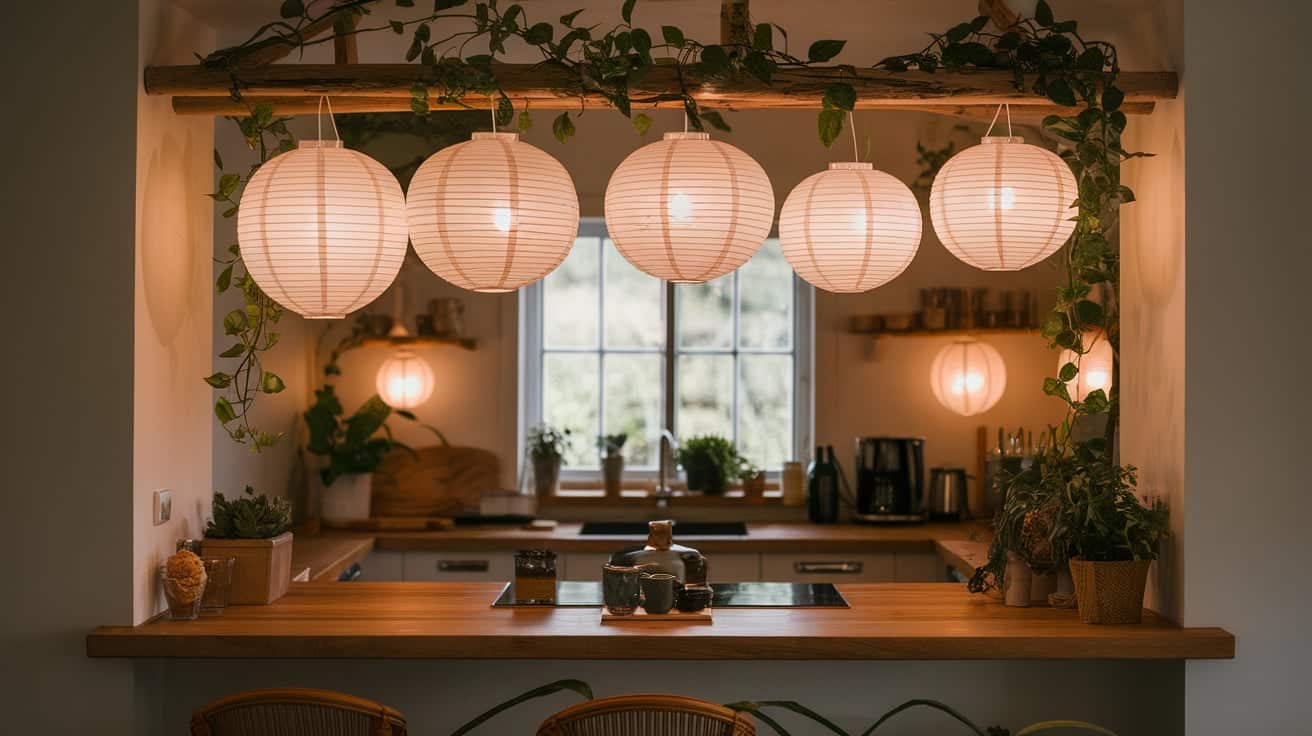
Paper lanterns provide soft, ambient lighting that creates a calm atmosphere. These lanterns, commonly used in Japanese design, add warmth and tranquility to the kitchen space.
Key points of this idea:
- Provides soft, diffused light for a cozy ambiance.
- Adds a touch of Japanese influence to the space.
Conclusion
Bringing Japandi style into your kitchen isn’t about following strict rules or completely overhauling your space overnight.
It’s about finding what works for you and your home. Start small – with wooden accessories or a few ceramic pieces – and build from there.
Remember, the beauty of Japandi lies in its flexibility and focus on what matters: creating a calm, functional space where you enjoy spending time.
When you’ve incorporated just a few elements or go all-in with a full renovation, how the space makes you feel counts.
After all, a kitchen should be more than just a place to cook – a sanctuary where functionality meets tranquility and every morning cup of coffee feels like a mindful moment.

